Record of program in 2011/2012
Record of program in 2012/2013
Program status Participants life
Participants in 2012/2013
| Country | Organization | Age | Sex | Rank, title, etc |
|---|---|---|---|---|
| Indonesia | Directorate General of Sea Transportation |
27 | Female | ISPS Code Auditor |
| Malaysia | Malaysian Maritime Enforcement Agency |
27 | Male | Operation Officer, District 11 (Lieutenant Maritime) |
| 27 | Male | Operation Officer, District 15 (Lieutenant Maritime) | ||
| Philippines | Philippines Coast Guard | 34 | Male | Flag Lieutenant (Lieutenant Junior Grade) |
| 34 | Male | Flag Secretary (Lieutenant Junior Grade) |
||
| Vietnam | Vietnam Maritime Administration |
31 | Male | Manager, SAR Department |
| Vietnam Marine Police | 34 | Male | Regional Vietnam Marine Police No. 4 (Senior Lieutenant) | |
| Japan | Japan Coast Guard | 27 | Male | 2nd Officer of Patrol Vessel(Ensign) |
| 26 | Male | 2nd Officer of Patrol Vessel(Ensign) |
The program status in 2012/2013
| Date | Activity |
|---|---|
| April 16 | |
| May 7 | |
| June 2-14 | |
| July 25-27 | |
| September 17-21 | |
| October 1-4 | |
| October 14 to November 1 | Maritime disaster prevention training |
| December 17 to 21 | |
| February 4 to 7 | |
| March 6 | |
| March 8 | |
| March 9 |
April 16, 2012 Participants arrived in Japan
Overseas participants from four different Asian countries (Indonesia, Malaysia, the Philippines and Vietnam) arrived in Japan.
After leaving Kansai airport by bus, they arrived at Hiroshima International Plaza. It took about four hours for them to travel to their accommodations.
Arrival |
Arrival |
Arrival |
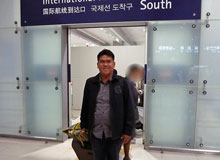 |
 |
 |
Arrival |
Arrival |
|
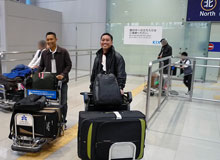 |
 |
|
Cherry blossoms in full bloom at HIP |
Participants arrived at HIP |
Brief explanation about the facility |
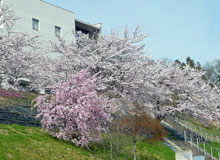 |
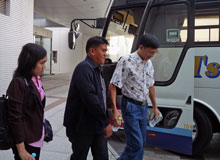 |
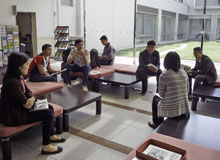 |
April 17, 2012 Orientation
The orientation was given to the participants at Hiroshima International Plaza. Despite their long flight to Japan,
they showed no fatigue and listened to the explanation about the training course and their stay at the facility by the training advisers.
Program orientation |
Program orientation |
Participants during the facility tour |
 |
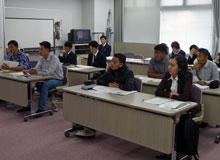 |
 |
April 22, 2012 All on board
One of the participants arrived in Japan finally. Now all are here in Hiroshima.
Arrival |
 |
May 7, 2012 The opening ceremony was held
The opening ceremony of the 2nd Asia Coast Guard Junior Officer Course of Japan was conducted at the Japan Coast Guard Academy.
Admiral Haruhiko Uryu, the Superintendent of JCG Academy, gave instruction to the participants. After the address by Mr. Kishimoto, Director General of the Administration Department, JCG, and Mr. Ishibashi, President of the Japan Coast Guard Association, one of the participants from Malaysian Maritime Enforcement Agency made a pledge to express his determination.
Instruction by Superintendent |
Address by Director General of the Administration Dept. |
Address by President of JCG Association |
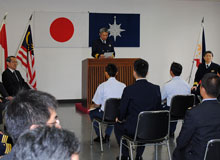 |
 |
 |
Pledge by the participant |
Commemorative group photo |
|
 |
 |
|
Before the opening ceremony, the participants had the 1st meeting with cadets of the Academy. Each participant introduced his/herself in Japanese. They had some Japanese language classes after coming to Japan. The representative of cadets delivered a word of welcome.
After the ceremony, orientation about the life at the Academy was given. They had a campus tour to facilities such as the library.
1st meeting with the cadets |
Orientation |
Observation of the library |
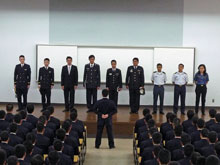 |
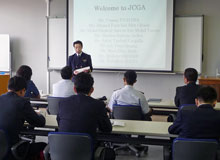 |
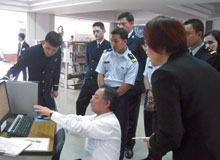 |
In the evening, a welcome reception was held. They had a good time with the Academy staff, cadets and other guests. Each participant introduced his/herself in Japanese.
Self-introduction in Japanese |
Participants in relaxed conversation with the Superintendent |
Participants in relaxed conversation with cadets |
 |
 |
 |
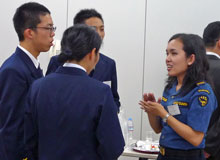 |
 |
 |
Commemorative group photo |
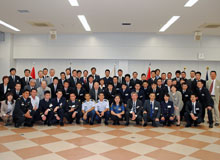 |
this one can be enlarged by clicking on this |
In the morning of the day, before the opening ceremony, the participants saw off the training ship Kojima for her around-the-world trip.
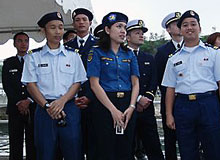 |
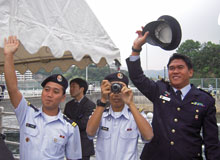 |
 |
May 8, 2012 Country and Job reports were presented
On the next day of the opening ceremony, the full-scale training at the JCG Academy began.
The participants presented the situation of maritime safety and security of their respective countries at the presentation session. The presentation was done with a very active question-and-answer session.
Participant earnestly presenting her report |
Used slide |
Many questions from the floor |
Used slide |
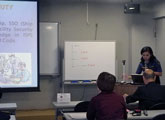 |
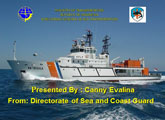 |
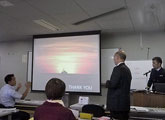 |
 |
Japanese participant also presenting |
Used slide |
Participant explaining current situation of his country |
Used slide |
 |
 |
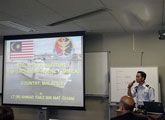 |
 |
Participant presenting experiences of his own duties |
Used slide |
Audiences listening to the presentation |
Used slide |
 |
 |
 |
 |
Heated presentation by a participant |
Used slide |
The 1st participant from Vietnam |
Used slide |
 |
 |
 |
 |
The 1st participant from Vietnam |
Used slide |
||
 |
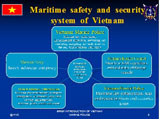 |
||
May 16, 2012 Exchange meeting with the students from World Maritime University
Participants had an exchange meeting with 27 students from World Maritime University, WMU, in Sweden at the brick hall of the JCG academy. Those students visited the Academy for obtaining and exchanging information about international maritime affairs.
They are scholarship students by the Ocean Policy Research Foundation from Asian and African countries. They stayed in Japan from 13 to 20 May as part of their training program and visited maritime institutions and coast guard related facilities to know the actual condition in Japan.
During the meeting both participants and students got to know each other and exchanged their views. At the end the students sang the WMU school song.
Starting with self-introductions |
Conversation over a cup of tea |
Conversation over a cup of tea |
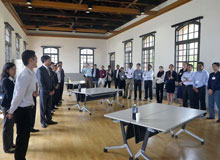 |
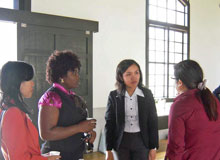 |
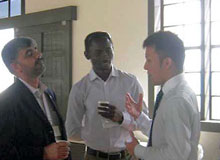 |
Conversation over a cup of tea |
They sang the WMU school song |
A big group photo at the end |
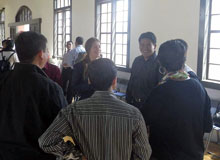 |
 |
 |
May 23, 2012 Participants tried rowing a cutter
AJOC participants had an opportunity to experience cutter training. Instructions were given by the JCGA cadets. They were the winning crew of women’s event and runners-up crew of men’s event at the all Japan cutter race.
At first, participants had difficulties to handle the long, thick and heavy oar. After 30-minute practice, they gradually became able to paddle in harmony by the unique call of “one, two and three.” They enjoyed their short cruise in the Kure bay.
Through this experience, they got to feel the importance of leadership, spirit, strength and cooperativeness necessary for junior officers of coast guard agencies.
Warming up to prevent injuries |
Embarked! Ready to depart |
Engine trouble? No, no engines! |
 |
 |
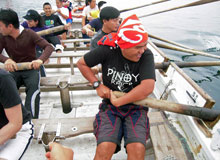 |
Paddling in harmony by the call |
Group photo with student instructors |
 |
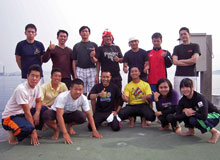 |
Comments from cadets
It was a good experience for me to have an opportunity to interact with AJOC participants through cutter training that is quite familiar to me. I appreciated them joining the activity and I’m very much pleased to know that they got interested in cutter. Though time was short, this interaction was a great opportunity for cadets. Thank you. (The 4th year cadet of regular course Mr. Kosuke Tsushima) |
On 23 May, nine AJOC participants tried rowing a cutter with five cadets of the cutter club. Once we used to use a cutter as a lifeboat in Japan, therefore, I don’t think it is familiar to most of the participants except two Japanese. It was an experience of one-hour training. I think that we could make them familiarize with cutter through our demonstrations. It was quite meaningful for us to interact with the participants through this activity. (The 3rd year cadet of regular course Mr. Norifumi Sudo) |
May 23, 2012 KAIJYOHOANDIGAKKO NO KATTA: SUBARASHII TAIKEN
(THE JCGA’S CUTTER: AN INTERESTING EXPERIENCE)
Don’t say that you love sport if you have not tried cutter. The cutter itself is like doing all kind of sport in one activity. You must be wondering…Why? Because when you paddle the cutter, every muscle in your body is used just like doing weight lifting and sit up. Imagine the oar (as a lifting) that you hold has weight around 10 kg and you have to up and down the oar in and out of the water while you also have to move your body to front then pull your body to back just like doing sit up.
That’s all…. That’s easy!!! (Maybe weight lifting athletes will answer like that). But wait, don’t make the conclusion so early. There are some factors to paddle the cutter. What are they? They are Brain and Hearing. Then another question appears… why we must use our brain to paddle the cutter? Just swing the oar, then your cutter will move. Some of you may answer like that. Yes…. we have to use our brain to paddle it in order to get harmonization with all cutter members who are paddling together. If not, your cutter will not move in one direction. It is just like playing chess (brain sport), which needs brain to make a strategy in every step that you make for every pawn.
And the last factor is hearing. WHY? Because every cutter member has to listen to what the cutter leader says. For example: when the cutter members have to paddle, and when they have to increase the speed. Not only an order but also a spirit the leader has to give to all member such as yelling GAN…….BA….TTE…!!!!!!!, so that they will not feel tired.
Warm up before paddling |
Happy to be onboard |
In the same spirit |
 |
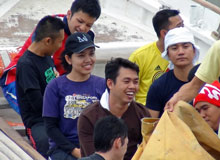 |
 |
This picture can be enlarged by clicking on it |
An interesting experience in the sea |
|
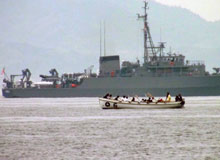 |
|
May 24, 2012 OBSERVATION OF PATROL VESSEL KUMANO
AJOC participants were given a chance to visit and see for themselves the equipment onboard Patrol Vessel Kumano that was alongside at the jetty of Japan Coast Guard Academy (JCGA). The purpose of the vessel at this time in JCGA is to coordinate and conduct training for divers of Japan Coast Guard. Patrol Vessel Kumano is a rescue ship based in Takamatsu of the 6th Regional Coast Guard.
At the beginning of the visit, all AJOC participants were welcomed by three officers of Kumano, Commanding Officer, Executive Officer and Chief Navigation Officer. The first time when I looked to the vessel, I thought it is just the same type and structure of ships that I have seen before. But, as the saying goes, your outer appearance does not represent its internal nature. I found that parable was true when I boarded the Kumano and started to observe from outside to inside of the vessel.
I felt very lucky and excited to onboard the vessel that’s so unique and equipped with various equipment for rescue. Why is Kumano unique? Because the vessel was constructed as a special patrol vessel with towing ability and the ability to control oil spills. I was attracted by the mast of the vessel because it’s equipped with three groups of water cannons to deal with fire incidents. This vessel is also equipped with experienced diver crew. During the visit, a briefing and explanation was given by Chief Navigation Officer.
In addition, AJOC participants also had the opportunity to visit the Patrol Craft Hayanami which was located next to Patrol Vessel Kumano. The craft called at the Academy to attend a training course in JCGA. As a result of the visit I have gained a deeper understanding of the role and functions of Patrol Vessel Kumano and Patrol Craft Hayanami, and also onboard experience issues.
Welcome visit from Officer of Kumano |
Explanation by Chief Navigation Officer |
Water cannons |
Description of the boat |
 |
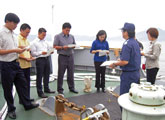 |
 |
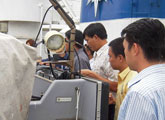 |
A boom to control the oil spills |
Navigation system |
Photographed with the officers |
How to control the throttle |
 |
 |
 |
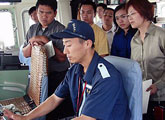 |
June 3, 2012 Participants observed the Sea Review and Comprehensive Drill
AJOC participants had an opportunity to observe the JCG’s Sea Review and Comprehensive Drill on board the patrol vessel Souya as part of the training in Tokyo.
All the participants stated that it would help citizens understand the missions of the JCG through showing this kind of training.
Among the drills, the rescue and maritime disaster prevention drill and the drill for capturing and controlling armed smuggling ships were quite impressive to them. Some of them mentioned that they would like to perform their duties with such well-equipped patrol vessels and aircraft.
Group photo in front of |
Boarding the patrol vessel Souya |
Observing the sea review |
|
 |
 |
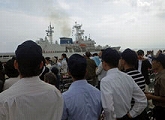 |
 |
Observing the formation flight of helicopters |
Observing the rescue drill |
||
 |
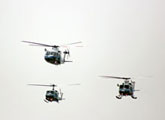 |
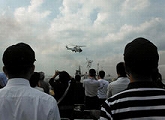 |
 |
Participants bidding farewell to the craft |
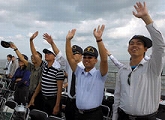 |
This picture can be enlarged by clicking on it |
June 4, 2012 Participants paid a courtesy call on the JCG top officials
At the start of the AJOC training in the Tokyo area, the participants made a courtesy visit to the JCG top officials.
At first the overseas participants introduced themselves in Japanese to Admiral Suzuki, Commandant, Mr.Masuno, Vice Commandant, Mr. Iwao, Vice Commandant for Operations, and Mr. Kishimoto, Director General of the Administration Department. The Japanese participants did it in English. They expressed their gratitude for having an opportunity to participate in this training.
Admiral Suzuki gave them encouragement to strengthen the bond between their organizations as well as to gain knowledge through the training.
During the visit, they talked about the sea review that they had observed the previous day. Most of them admired the disciplined drills. Admiral Suzuki explained that it is important to have the public understand the missions of the JCG by looking closely at the various drills.
At last Canny from Indonesia presented a batik, traditional Indonesian fabric, to Admiral Suzuki.
After the visit, the participants had a lecture on “Leadership” by Mr. Sato, Director General of the Guard and Rescue Department. They actively attended the session asking many questions.
Self-introduction in Japanese |
Words of encouragement from |
 |
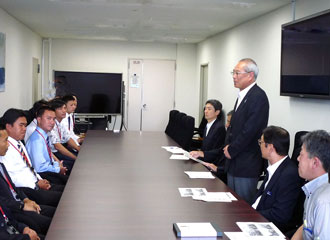 |
Indonesian participant presenting a batik |
Commemorative photo with executives |
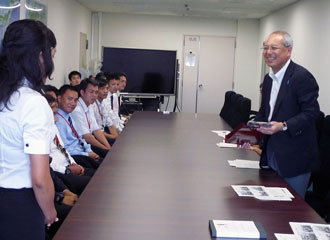 |
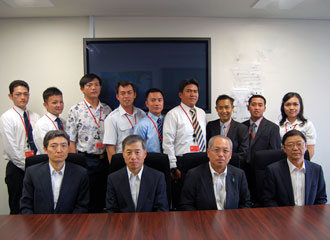 |
This picture can be enlarged by clicking on it |
Lecture by Director General of |
 |
June 5, 2012 Start of intensive lectures in Tokyo about the Coast Guard missions
A seminar on the Coast Guard missions started in the seminar room of the Hydrographic and Oceanographic Department.
From June 5 to 13, the participants are systematically to be briefed about the general missions of the JCG from various lecturers of different divisions within the headquarters.
On the first day, they had a lecture on organizational management and the education and training system of the JCG. They engaged in heated discussion and we could tell how earnestly they tried to acquire more knowledge.
At the entrance of the Hydrographic and Oceanographic Department |
 |
Seminar in Tokyo started |
|
 |
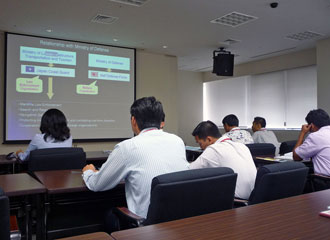 |
June 3 to 13, 2012 STUDY TRIP IN TOKYO
Our first study trip in Tokyo was very meaningful to us. The staff of JCG made a lot of effort to make our visit as interesting as possible. I just want to share my memorable moment during this study trip.
On our first day, we had our first lecture about leadership. I thought what I have learned from the book about the meaning of leadership is enough. It was even more interesting when Vice Admiral Yuji Sato spoke came from his heart and said “so I may be not qualified to speak about leadership but my suggestions are based on my real-life experience during my 35 years in the service”, I felt pleased with his humble remarks in spite of his achievements. His leadership skill was developed when he was assigned aboard ship then as high-ranking officer of the ship. He inspired us of what he has accomplished in his career. I am very optimistic that the experiences he has shared with us provide us a perfect fit to our needs to become more effective in our field as future leaders. I felt very lucky when I heard such experiences from Vice Admiral Sato because after this AJOC class I might be assigned aboard ship and I can apply what I have learned from him. And I believed all participants thought the same way too.
Moreover, we also took advantage to gain knowledge from the members of JCG staff lecturers by exchanging experiences on maritime issues and its applications and interact with our fellow participants to share and benefit from each other’s experiences.
On the lighter moment, our colleague from Japan Aki-san and Taka-san organized social activities so that participants could see interesting part of Tokyo. These activities included a tour around the midtown Roppongi District, at the top of 150 meter Tokyo Tower, electronic city in Akihabara, and Tokyo Disney land to name a few.
Likewise, this trip also gave us the opportunity to visit the Nippon Foundation office as one of the major sponsor to this course. It was indeed with an unforgettable week in Tokyo.
Various classes were held |
Very attentive participants |
 |
 |
Q&A over their break |
Presentation was given |
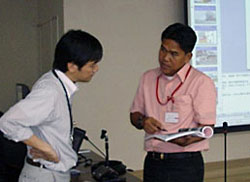 |
 |
June 4, 2012 Participants visited JCG Headquarters
Following with our hectic schedules, AJOC participants paid a courtesy call to the Commandant Japan Coast Guard, Admiral Hisayasu SUZUKI with JCG executives, Vice Admiral Ryuji MASUNO, Vice Commandant ;Vice Admiral Masayuki IWAO, Vice Commandant for operations and Vice Admiral Kunio KISHIMOTO, Director General of the Administration Department. The Commandant expressed his full support and appreciation to the participants for our cooperation and our dedication to learn from this course. And he spoke about the introduction of the last year’s 1st AJOC Class of the Coast Guard Capacity Improvement Program. Though it was meant to be a formal meeting, the commandant was really surprised as the participants introduced themselves in Japanese language. And it was concluded by a question and answer about our impression in Japanese culture and our impression on the sea review and comprehensive drill of JCG.
After our courtesy call, a warmed welcome reception was prepared to us by JCG staff and attended by JCG’s top officials. At this time, each participant expressed their sincere thanks to the JCG Officers and men for their hospitality and their unwavering support to us. Afterwards, we were entertained by a cultural dance number of Capt. Toyama and of course followed by a dance presentation number from AJOC participants. It was indeed a happy night for all of us as we were acquainted with each other.
Meeting with Admiral Suzuki |
Commemorative photo with the executives |
 |
 |
Performance by the participants |
All having a good time together |
 |
 |
June 13, 2012 Participants visited the Nippon Foundation
AJOC participants paid a courtesy call on Mr. Unno, Executive Director of the Nippon Foundation, on their last day in Tokyo.
At first the participants introduced themselves in Japanese and expressed their gratitude for having the opportunity to participate in this useful training.
Then Mr Unno gave them following remarks of encouragement:
Issues related to the world ocean and maritime affairs are diverse and intertwined. Moreover, as oceans straddle national borders, no single country can solve them. Expertise in one specific field is unlikely to solve them, either. In order to address these issues, the Nippon Foundation has been developing human resources who have global and interdisciplinary perspectives by collaborating with various organizations in the world. The foundation established the network of the maritime professionals beyond borders and disciplines. After the completion of this training, we expect that you will take part in the network and contribute to address the challenges related to the world ocean.
The success of the program is assessed not so much by obtaining knowledge and good experiences but by harnessing them to your work after returning. Please always be aware of this.
In addition, it is also considered that constructing a human network among not only participants but also concerned parties who support the program is part of the outcome. Through this program you will be an integral part of the Nippon Foundation’s network and you will let us into your own networks in the same way. Then we hope you will make extensive use of those networks on your return.
We are looking forward to seeing you in eight months at the end of the training with your brilliant faces.
Courtesy visit to the Nippon Foundation |
Participants introducing themselves in Japanese |
 |
 |
Words of encouragement from Mr.Unno |
Commemorative photo |
 |
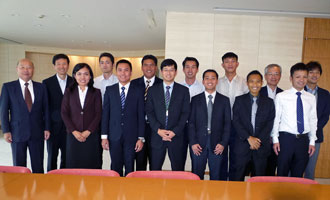 |
This picture can be enlarged by clicking on it |
June 13, 2012 VISIT TO THE NIPPON FOUNDATION
During the Tokyo study trip from June 3 to 13, the AJOC participants had the opportunity to visit the Nippon Foundation. All participants could have a meeting with Mr. Unno, Executive Director of the Nippon Foundation.
Initially the air was very solemn in the meeting and the AJOC participants introduced themselves in Japanese. Then Mr. Unno very kindly asked the course members about: life in Japan, where to visit for weekends, how the condition of this course was and so on..., and that made the air of the meeting become more open. He also clearly stated the purpose of the course and the necessity of international cooperation among the countries in Southeast Asia. This training course is really necessary.
We are all grateful for the support from the Nippon Foundation and his advising words for this course. Because the knowledge, or what we learned through this training in Japan will surely help develop all the members of AJOC. We contribute positively to the strengthening and developing organizations of each participating country. Although the meeting was very short, the AJOC participants thanked very much for the open welcome by Mr. Unno.
We will do our best to achieve the purpose of the course and the expectations toward us. We took souvenir photos and concluded the meeting believing the success of this course.
Courtesy visit to the Nippon Foundation |
Commemorative photo |
 |
 |
This picture can be enlarged by clicking on it |
June 15, 2012 The arresting technique exercise started
Under the guidance of instructors of the training department of the Japan Coast Guard Academy, the participants practiced the arresting technique with the help of the club members as part of interaction activities.
The technique has been taught and disseminated to the coast guard agencies in the South East Asian countries based on their needs through dispatched experts. However, it was the first time for all of them. The first step was to learn how to tie the belt. As the lessons went on, they got the hang of it. With their interest in Japanese martial arts, all of them tried hard.
The lesson developed their use of the arresting technique as well as their interaction with the instructors and cadets.
Starting with tying the belt |
Lessons are supported by cadets |
 |
 |
Training of control procedure |
The atmosphere in the lesson was good |
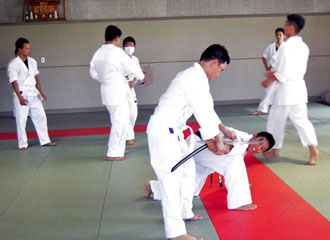 |
 |
This picture can be enlarged by clicking on it |
June 27-29, 2012 International Cadet Exchange Program: It is a small world!!
On 27th-29th June 2012, the International Cadet Exchange Program was held at JCGA. This is the 21st program organized once a year, with the theme of Hand In Hand: Coast Guard Without A Limit. It involves 2 participants from each organization which are Canadian Coast Guard College, Korea Maritime University, United States Coast Guard Academy and the cadets of Japan Coast Guard Academy. AJOC participants were invited to observe the program. JCGA’s cadet told the story of One-Inch Boy JCGA’s cadets performing the KMU’s physical training. Playing the musical instrument Playing the musical instrument Playing the musical instrument As part of practical subjects, the training in initial investigation was given. Initial investigation is the basics of criminal investigation. The training was given by a lecturer from the Criminal Affairs Division of the Japan Coast Guard, and by some crew of a patrol vessel of a designated ship for identification, from Hiroshima Coast Guard Office. Explanation about initial investigation procedure Basic photography Precautions of bloodstains collection Fingerprints collection training In JCG, we use a technique called seiatsu-jutsu or arresting technique when we apprehend resisting suspects. This technique does not attack opponents like martial arts but pacifies them with safety. In other words, we use the minimum and swift actions necessary for arresting suspects. Under this concept, AJOC participants practiced the seiatsu-jutsu. So far, we have learned several techniques such as ukemi, ridatsu, kansetsu-waza and so on. Ukemi and ridatsu are skills to protect oneself from attack and kansetsu-waza is one of the skills to pacify opponents by twisting their joints. All of us practiced Practice using tools Practice using tools First day, AJOC participants visited Sendai Nuclear Power Plant (SNPP). As we know that almost electricity in Japan is produced by Nuclear Power Plant. Until today only 2 of them are operated after 3/11 tsunami, but now SNPP is not operated. At the plant, the SNPP officer explained to us how the electricity produced, and we also watched the video about the history of SNPP then we had 1 hour site visit in SNPP. Next activity was the reception in 10th JCG Regional Headquarter. The officers welcomed the AJOC participants and we had an interesting conversation to share the information about their organization, country and themselves. And overseas AJOC participants also had a tanoshikatta experience such as dancing the Ohala-Bushi (traditional Japanese dance) with the custom and headband, watching Kendo and listening to the traditional Japanese music performed by 10th JCG Regional Headquarter officers. Observing the structure model at the plant Warm and friendly welcome Observing a tanker at the station Group photo near Mt. Sakurajima Lecture by Director of Guard & Rescue Dept Roads were covered with volcanic ash The training ship Kojima returned to Japan Coast Guard Academy (JCGA) on rainy and cold Saturday. It seemed very welcomed and has really missed her return. This is because many people eagerly awaited her arrival, after surfing the seas around the world for three months. Seen their waiting faces radiated joy after seeing the training ship Kojima started to approach the JCGA jetty. Her return was eagerly awaited by the Superintendent, Vice Superintendent, trainers and educators of JCGA, the academy staff and certainly the most happiest were the parents of cadets on board Kojima, who had been missing their children who will become Japan Coast Guard (JCG) Officers. Awaiting arrival of Kojima Finally, Kojima arrived safely MMEA training on board Kojima Commemorative photo JCGA facility tour Observing the Engine Room on board Kojima
Now, AJOC participants are taking classes about appropriate management of Hazardous and Noxious Substances (HNS) and how to cope with HNS accidents. Briefing on the experiments Explanation about how to handle chemicals Transferring the chemical into the tank From 17th September to 21th we visited, as a study tour, Okinawa, in which 11th Regional Coast Guard Headquarters is located. Jurisdictional area of the 11th region covers the Senkaku Islands and we could experience really tense situation over the Islands through this trip. Courtesy call on Commander of 11th Regional CG HQ Lecture on guard mission Observation of helicopters Observation of the training by mobile rescue members Experiencing the control training Onboard a high speed lubber boat Observing the experiment at GODAC Visiting Shurijo castle On October 1st 2012, AJOC participants began the study trip visiting the JCG Air Station in Kansai which is located inside Kansai airport built in a floating island. One hour lecture was conducted by the JCG officers and one of them explained that the air station in Kansai has the functions of a JCG Office and a JCG Air Station where they conduct maritime safety and security activities on sea and in air. After the lecture, we had a chance to see the performance of SAR activity with the scenario of rescuing victims by using a helicopter or a fixed-wing airplane. We visited the sophisticated JCG aircrafts, for example: helicopters and fixed-wing airplanes. I was very impressed to see them and I thought the JCG Air Station can be a good role model for another country which has not yet aircrafts base. Briefing on the CG Air Station In front of the CG Air Station Next day, AJOC participants went to Kobe where I saw many artistic bridges. We visited Kobe University. At the university, we had a short lecture which explained about the history of Kobe University as the 1st university in Japan that has the faculty of Maritime Science and the curriculum, etc. At noon it was cloudy and we had a chance to visit the training ship Fukae-Maru, then onboard the sailing yacht (the combination of using machine and wind power to sail) which was very “tanoshikatta desu” for me. Visiting the faculty of Maritime Science, Kobe University Sailing is important for leadership The following day, we went to Maizuru, a city that slightly has a similar atmosphere with Higashi-Hiroshima but no rice-field. The JCG School is located in the city. At the school, we had a warm welcome from the Superintendent in his office. Then a short lecture was given by the officer and we continued to visit the facilities such as indoor swimming pool, dormitory, helicopter hangar, etc. In the afternoon, we visited the training ship for JCGS students, PL 22 “MIURA,” that can be landed by one helicopter. At the end of our visit, the JCGS officer gave us a JCG School cap as a souvenir. On the deck of the training ship at JCGS The training ship MIURA Through this study trip, I realize how well-prepared Japan Coast Guard conducts maritime safety and security activities in their territorial sea and EEZ because I could see that from their sophisticated assets, officers’ skills, and how JCG educates the cadets who will be the ensigns and the enlisted without any different treatment. Two thumbs up CC for that. -A week-long training but it’s all worth it- We had several study trips before but our stay at Yokosuka for one week was the most challenging and comprehensive when it comes to learning so far. AJOC participants were given an opportunity to take a package course on fire fighting and oil spill response at Maritime Disaster Prevention Center (MDPC), an excellent and only institution in Japan that provides training for maritime disaster prevention. Classroom lecture with AJOC & JICA participants With brave hearts, AJOC faces the fire with teary eyes this one can be enlarged by clicking on this Brainstorming and strategy planning We are ready…so bring it on!! The faces that conquer the fire AJOC learns to deploy boom properly this one can be enlarged by clicking on this Proud smile from the fire fighters this one can be enlarged by clicking on this 10 years ago, in 2002 Yokohama was the city where the World Cup 2002 final between Brazil and Germany was taken place, and the AJOC 2012 participants had an opportunity to stay in Yokohama city from October 20 to 25. Setting a portable antenna Adjusting the direction of the antenna Commemorative photo with staff At the end of the study trip in the Kanto region, the participants made a courtesy visit to Mr. Unno, Executive Director of the Nippon Foundation.
On the first day, there was meeting ceremony with the foreign participants at the dormitory class room. Even though they just arrived, they used some Japanese words in their ice-breaking session. Thanks to JCGA’s cadets, they settled very well and seemed very comfortable living in the academy.
On the 2nd day, they attended the Integrated Training Building with special lecture from Professor Yamaji. The lecture not only gave us the others knowledge about WIG-craft, but also let us think outside the box with a game given earlier of the session. The lecture ended with the traditional story of One-Inch Boy, purposed to motivate the audience to believe in one-self and to have courage to do remarkable and extraordinary things.
The 2nd session of the day was the Cadets International Conference. In this session, cadets from each organization presented about their academy’s life, and their daily routines. We also learnt about the facilities, the sports and other activities, the training ships, and the academic contents from each organization via presentation and videos. In addition, the participants from Korea showed their festival for marine protection, which was remarkable. They also demonstrated their physical training on the stage. I tried by myself at HIP (to be honest it was really hard and challenging to do that for 1 minute!). I was impressed with the military life system of USCGA and the dormitory of CCGC which simulate the structure of real ship.
The conference continued on final day with the discussion about life, culture and language for each country. The discussion was very fun where we were shown the live and edited version of sumo wrestling and the comedy show by JCGA’s cadets. The foreign participants including us also shared each country’s jokes, traditional sports and martial arts (plus the Taekwondo demonstration from Korean participant).
It continued in the afternoon, with the Experience of Japanese Culture program. There we were presented with Japanese traditional music played by Koto, Shakuhachi and Sangen. I was impressed by the cadets and the teachers (including the Vice-Superintendent of JCGA) for their talents in performing the music. The Japanese Tea Ceremony was also performed, including the wishes tree of Tanabata and the art of Origami. At the end of the session we experienced playing the traditional instruments, performing the tea ceremony, making our own origami and wrote our wishes and hung it on the tree.
The program was successful in developing international relationship among participants, and delivered the knowledge in sharing of life, language, cultures and customs. It was great experience for all of us. 1 thing I learn, even though the differences of continent, language, race, religion and culture, there are no barrier against us. It is truly a small world!
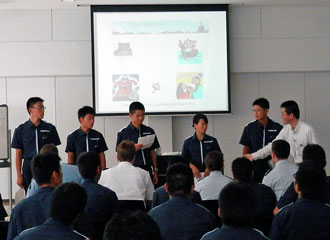
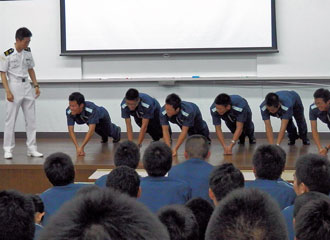
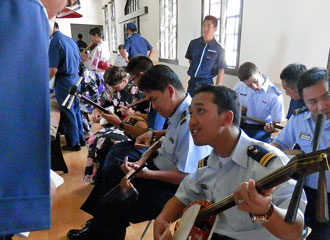
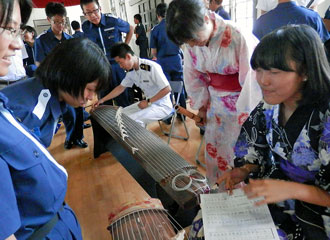
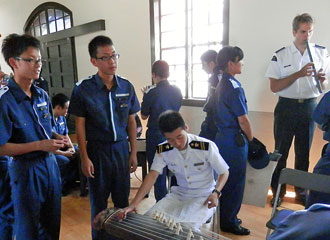
July 5 and 6, 2012 Initial Investigation Training
On the first day, explanation about the significance and procedure of initial investigation was given. On the second day, a mock crime scene was set in the classroom and the practical training became more real. In the practice, the procedure was explained one by one such as setting of off-limits area, preservation of the scene, questioning of suspects and witnesses, basic photography, bloodstains collection, footprints collection. The participants did them by themselves and found the significance and importance of initial investigation.

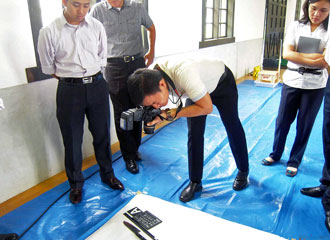


July 3, 2012 Arresting technique training
We wear a uniform called a do-gi during the training. One of the participants joked that they look like Sushi-chef when dressed in do-gi.
Through this training, I hope every participant understands the JCG’s unique technique and that we build common understanding as we are engaged in the same kind of missions.

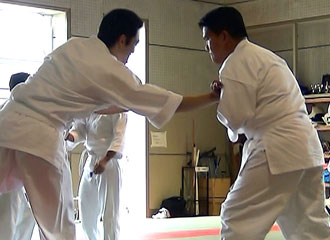
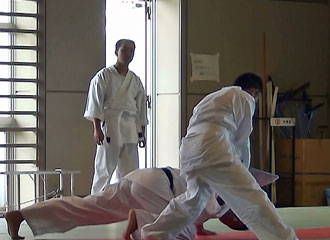
July 25-27, 2012 Visiting The Amazing Facilities in Kagoshima with MASK
Second day, we visited the Kiire Petroleum Reserve Station. Through the explanation and site visit, AJOC participants learned that the station stands by if there are any unexpected incidents happen such as tsunami, terrorism, oil pollution and even earthquake which is the big concern for them because the station is located only few miles from Sakurajima volcano. Our next visit of the day was Sakurajima Visitor Center. From the provided video, we could see the history about the volcano which was coughing ashes when we visited there.
Last day, AJOC participants had a lecture given by Capt. Hiroyasu ITO in 10th JCG Regional Headquarter. He explained to us the mission of his office, their activities on the dispute islands, spy ship accident and JCG’s countermeasure.
Japan is known as a mountainous (active and inactive volcanoes) country which means any natural disasters can happen unexpectedly. But after the visit, we know that Japanese Government through the designated organizations (JCG, MSDF, Fire Department, etc.) stands by with countermeasure if any disasters happen and very concern about the safety and security in the plant and station and also how to make the plant and the station harmonize with nature.
Thank you JCG for providing us the useful study trip and also Sakurajima for your unforgettable small eruption.
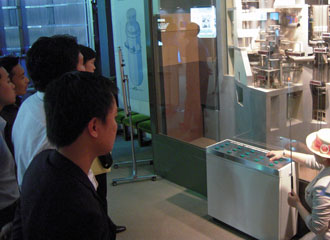
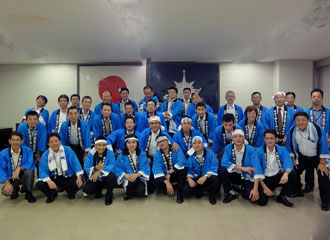
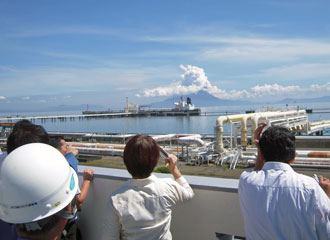
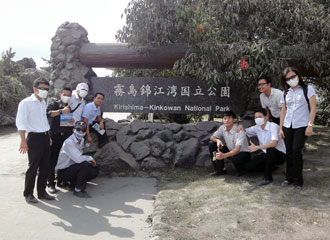
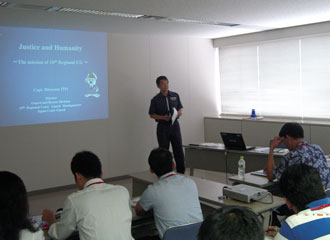
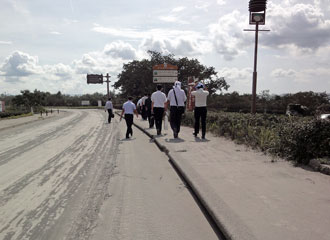
August 11, 2012 The Return of Kojima With MMEA Officers
The arrival of this ship was also awaited by me and Anwar-san because some of our colleagues were also on board Kojima. Four officers of the MMEA had been invited by the JCG to undergo Ocean Training Cruise with JCG cadets for 10 days from Singapore to Kure, Japan. We waved at them with pride and joy from the jetty. Precisely at 9 am, Kojima was safely alongside at the jetty of JCGA. After that, we also had the opportunity to jointly attend the arrival ceremony. After receiving speeches expressed by the Captain of Kojima and the representative of cadet officers, Admiral Haruhiko Uryu, the Superintendent of JCG Academy, gave a welcome speech and an appreciation to those who involved in the training ship Kojima for her around-the-world trip.
After the event, we met and chatted with our friends from the MMEA. They related their experiences and activities throughout the voyage with Kojima. It appeared they were very satisfied and happy to have the opportunity to gain knowledge on a large training ship equipped with appropriate equipment for training. Then we visited the JCGA facilities such as a gymnasium and a museum together. We also demonstrated to them some of the technique to arrest that we have learned from the arresting technique class. Prof. Yamaji guided us along this tour. We also were brought to observe Kojima. Interestingly, we were brought by our colleagues to observe Kojima. They explained to us what they had learned with the equipment onboard the ship.
After completion of all program arranged for the day, we bid farewell as they will continue their program with JICA Yokohama in Tokyo for 4 days before returning to Malaysia. What I felt is that the program such of this training to our agency officials is very useful, especially to young officers. Their experience and knowledge gained can be shared with our agency. Hopefully this training program can be continued as a tradition of an annual training between MMEA and JCG.
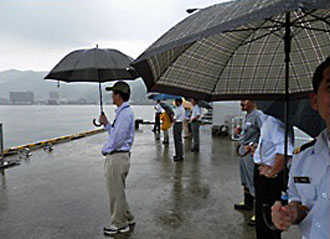




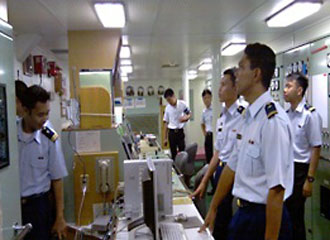
August 27, 2012 Hazardous and Noxious Substances (HNS) Experiment
People tend to associate that it is just an accident in the chemical company or the laboratory when they hear ‘Hazardous and Noxious Substances (HNS) accidents’. But it is also related to coast guard activities. At the sea throughout the world, there are many vessels loading hazardous and noxious substances and they navigate every day. When those vessels cause an accident, we have to cope with it.
Previous time, we carried out combustion experiment about ‘Pentane’ and ‘Acetylene’. These substances are flammable chemicals and the range of combustion concentration is limited. That is to say, under the condition that it is either too high or too low concentration, these substances cannot burn. So we have to know the vapor concentration of them whenever these substances flow out within the tank of a vessel.
In this experiment, we assumed a 20-liter polyethylene tank that was poured ‘Pentane’ and ‘Acetylene’ as inside of a tank of a vessel. And under various vapor concentrations, we tried to ignite by using fuse. In spite of a small quantity of chemical, a roaring sound like explosion was made and it burned. At that time, I felt that if this had been an actual vessel accident, it would become a catastrophe.
Through this experiment, I realized again the danger of our activities and the importance of improving our response capabilities to ‘Hazardous and Noxious Substances (HNS) accidents’.


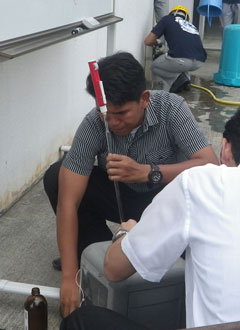
September 17 to 21, 2012 Study tour to Okinawa
As the first program we made a courtesy call on Rear Admiral MAJIMA, Commander of 11th Regional CG HQ , and then got the lecture on guard mission on the sea area around the Senkaku Islands, which is one of the primary operations of 11th Regional CG HQ. Rear Admiral MAJIMA, in spite of such tense and hectic circumstances, managed to make time to meet us. Besides that, he sincerely welcomed us, which impressed us extremely. As to the lecture, the participants were avidly listening in the lecture on how JCG responds to security threat around the Senkaku Islands, comparing to issues over the marine boundary that each of his/her own countries confronts.
On the next day we visited Naha Air Station and observed aircraft based in there and the rescue training of Mobile Rescue Team. The participants seriously stared the prompt and accurate rescue techniques of the MRT members, who engage in the duty of protecting national’s life such as transferring urgent patients in 11th district, remote islands region.
On the 4th day we visited Nakagusuku Coast Guard Office and Global Oceanographic Data Center. At the office we were briefed about their operations and had an experience to onboard the high-speed lubber boat. We observed the control training as part of maritime security training. During the training the participants had an opportunity to perform the result of their arresting technique class at the JCG Academy.
We observed Shurijyo castle on the final day in order to study historical and cultural background of the Ryukyu Dynasty which had uniquely flourished until 1872 when the Meiji government installed Ryukyu-Han.
Through this tour for study, in terms of securing the safety on the oceans, we could grasp what important roles remote islands region assumes for Japan, small island states composed of more than 6000 islands, and East Asian countries, archipelagic states made up of more islands.


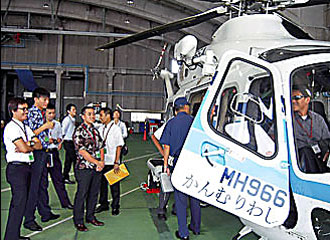
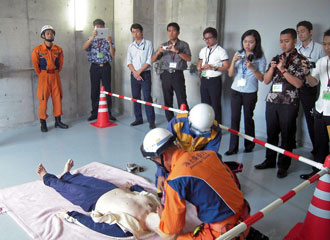
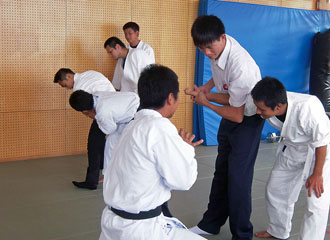
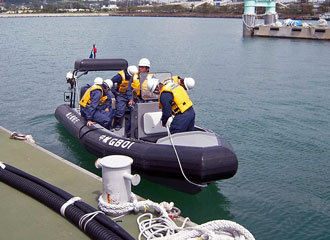
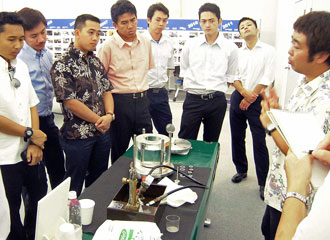

October 1 to 4, 2012 Kansai, Kobe and Maizuru: the impressive study trip

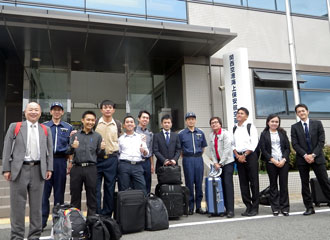
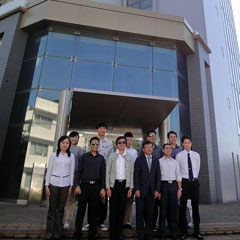

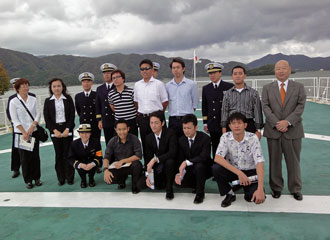
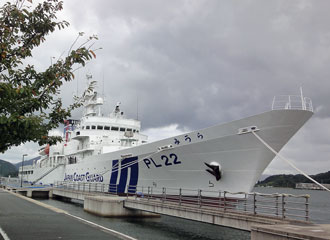
October 15 to 29, 2012 AJOC participants fight against fire and respond oil spill
For this week-long training, two (2) days were spent for classroom instruction wherein basically they taught us general knowledge, from classification of fire, theory of combustion down to several techniques on how to combat or extinguish fire on different situations. The third day onwards was the most exciting and challenging part of the training since this time, we did the actual exercises on fire fighting. There is an island where the MDPC has facilities dedicated to be used on this kind of exercises. For this actual exercise, using a mock-up ship, we utilized their fire-fighting facilities that actually created a real fire situation that happens in ship and petroleum and LPG facilities. We started our firefighting exercise from basic to the most advance including hose handling, strategy making, size up tactics and command and control down to materials being used to extinguish fire such as foam or dry chemical extinguisher, fixed apparatus and water fog. We were given situations such as how to attack and defense to protect ourselves from oil fire in the engine room of the ship, fire that emerge in the cabin, broken tank and deck and many other situations that we might possibly encounter in the future.
These two (2) days actual exercises were physically and mentally challenging in the sense that we did not use just physical strength and faced thick smoke that made our eyes teary to extinguish fire but it made us think as well on what was the best strategy to use in a certain situation.
Then on the morning of the 5th day, lecture was given on characteristics of spilled oil and the manner on how to deploy booms, shoreline clean-up and other important things that we need to know as we respond to this kind of incident. For the last exercise, we were given the opportunity to actually experience how to properly deploy the boom and it made us realize that it wasn’t as easy as we thought. After which, we took an exam for our instructors to evaluate us if we indeed learned something from this course before finally handling us our certificate of completion.
Aside from the knowledge and skills that we gained from this course, other good thing about it was that we took the course together with the JICA participants. The opportunity to interact and brainstorm with them, meeting people and making new friends made the whole experience more worthwhile and special.
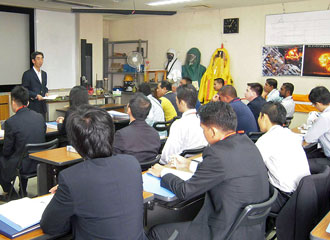

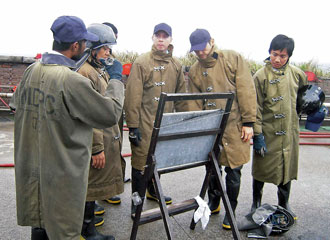
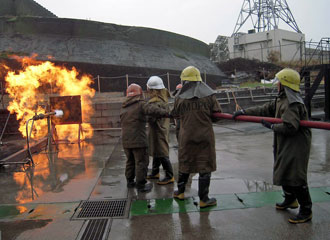



October 20 - 25, 2012 Yokohama “a beautiful port city”
We visited the 3rd Regional Coast Guard Headquarters, Yokohama Maritime Disaster Prevention Base, and Tokyo Bay VTS Center. This program gave me a comprehensive view of the Regional HQ under the JCG HQ. At the Command Operation Center of the 3rd Regional HQ, we received an explanation about the function of Rescue Coordination Center, RCC, and observed the operation of Japan Coast Guard 118 Emergency Call. The mission is very much related to maritime security and maritime safety. The 3rd Regional HQ is an ideal organization. It is not only because of a strong number of patrol ships and multifunction ships, but also because of the organization system which is well established and synchronized to accomplish tasks effectively.
There were a lot of things to learn from the program content. The most impressive was the actual practice using the equipment for online broadcasting signal transmission in Yokohama Maritime Disaster Prevention Base. With this system the images of the scene taken by a helicopter can be transmitted to the JCG 3rd Regional HQ by radio wave or satellite. Each Regional HQs of JCG has the same system. So that it is possible to promptly respond to requests from the scene, which is very important. JCG has installed the corresponding device suitable for this task. Perhaps this experience was the first time experience and very useful for the AJOC participants.
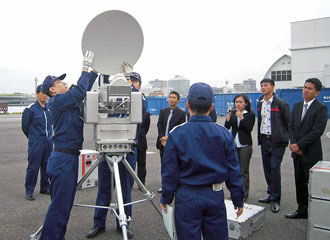


October 30, 2012 Participants paid a courtesy call on the Nippon Foundation
At first each participant stated his/her impressions about the training after 6 months of their stay:
Then Mr. Unno sent them back the message:
Courtesy call on Mr. Unno, Executive Director |
Participants telling about the ongoing training |
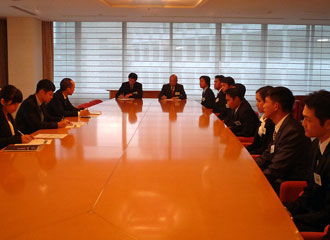 |
 |
Commemorative photo of the visit |
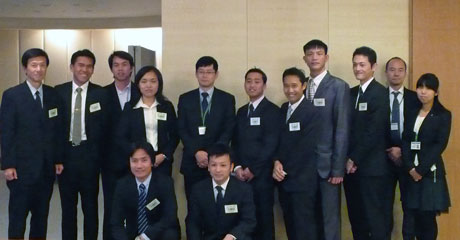 |
October 29 to 31, 2012 TOKYO -THE CITY OF AUTUMN
After leaving Yokohama, our class has continued to travel to Tokyo. Along the way, we could feel the breath of autumn was coming. Leaves of Japanese maples turned red, orange, and yellow, and they were so beautiful. I like autumn because the cool and breezy days are a welcome relief from the heat and humidity of summer. Autumn was here. The cool wind felt nice. Just walking along the streets, it was a pleasure to see the leaves turning to the autumn hues of red and yellow. Tokyo has many parks and city squares, including large green areas, those parks and botanical gardens are well kept. We could enjoy the autumn leaves as well as flowers like chrysanthemums and cosmos without leaving the city.
We have had an opportunity to come back JCG hydrographic and Oceanographic Department where we have had a lecture about overview of the Department and attended a facility tour to Notice to Mariner, Nautical Chart Editing Room and Oceanographic Museum. The next day at JCG HQ we have had a courtesy call on Director General of the Admin Dept. to report on the results achieved after six months of study in the Japan Coast Guard Academy.
During the following 3 days, we have had a busy schedule including lectures and facility tours in the JCG Research Center, JCG Haneda Air Station and Japan Maritime Science Inc. and Nippon Yusen Kaisha Container Terminal. All participants were interested in meaningful lectures and interesting facility tours. We have gained much knowledge and experience about the organizational structure as well as day-to-day activities of the Japan Coast Guard. At the JCG Research Center, we have had a good opportunity to study about the duties of the scientific criminal investigation study section. We have been taught how to analyze ship’s paint film concerning collision accidents between ships and methods to detect drugs. At JCG Haneda Air Station, we have had an interesting lecture about the organization, scope and responsibility of the station. With modern assets consisting of 6 highly specialized aircraft for an ever increasing patrol area, the station is responsible for several coast guard missions including maritime safety and security. Through collaboration with the Special Rescue Team, the station is always ready for difficult maritime search and rescue missions in maritime incidents or natural disasters.
It was nearly one week we stayed in Tokyo since we had left beautiful port city Yokohama. In the largest cities of the world, we have had many meaningful activities in our study trip. The hustle steps on the stairs, the moments waiting for trains in subway, the hurry walking in sidewalks covered full of red and yellow leaves of Japanese maples, we could feel our love for Tokyo. Tokyo- you are always in our hearts.
Observing chart making process |
Courtesy call on DG of the Administration Dept. |
 |
 |
Practice on preliminary examinations of drugs |
Hoisted with the gear at the Haneda Air Station |
 |
 |
Mock class on ECDIS at Japan Marine Science Inc. |
With a huge container vessel |
 |
 |
November 15, 2012 Underwater Safety Management by SONAR Visualization
AJOC participants had practical training on the technique for underwater exploration and underwater safety management. Prior to the practice, they had learned in the lecture about the effectiveness of sound waves as a means to observe under the sea, various SONAR technologies, and their applications. An underwater acoustic imaging device (visualization SONAR) and its principle had been explained to them.
It was cold and windy day. The participants boarded ITSUMORI, which was rigged with the special device. In Kure bay they took images of underwater objects by acoustic video camera and saw them on the screen display in the wheelhouse. With this device it is possible to observe objects even when visibility is poor and inspection is not possible by conventional underwater camera.
Through this practice they could experience that an underwater acoustic video camera can be an effective equipment substitute for a submersible survey in the fields of underwater exploration and underwater safety management.
Participants receiving the explanation |
Underwater acoustic video camera |
 |
 |
Participants intently observing the display |
 |
Image of artificial fish reefs on the display |
 |
November 27, 2012 The JCG Band concert in Kure city
AJOC participants went to the JCG Band concert held at Kure City Bunka Hall. The concert was held to commemorate the 60th anniversary of the relocation of the JCG Academy to Kure and the city’s 110th anniversary. Marches and music related to Kure city were played and citizens enjoyed the music.
The JCG Band activity is a part of the PR activities of the JCG. The participants saw the concert hall filled with citizens and they could feel the Band’s activity close to them. One of the Japanese ex-participants is a member of the Band. They were lucky to see how active she is in various fields of the JCG mission.
JCG Band concert |
An appreciative audience |
 |
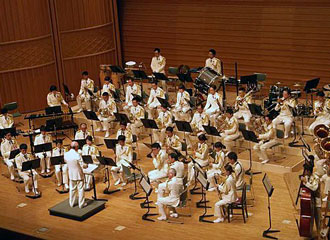 |
November 30, 2012 Special lecture -Malaysian Maritime Enforcement Agency-
Mr. Abdul Rahim bin Hussin from Malaysia visited the Japan Coast Guard Academy. He is Undersecretary of the National Security Council, Prime Minister’s Department.
AJOC participants had an opportunity to attend a special lecture by Mr. Rahim with the participants of International Affairs Course of the JCG Academy. In his lecture, he talked about the establishment of the MMEA, its current operation, future perspective and his expectations toward the audience.
Participants listened attentively to him. During the Q&A session, there was a question about the challenges he faced in the process of establishment. He mentioned the difficulty of unifying a new agency made up of people from various organizations.
The two AJOC participants from the MMEA also listened intently to him.
Lecture by Mr. Rahim |
The Q&A session |
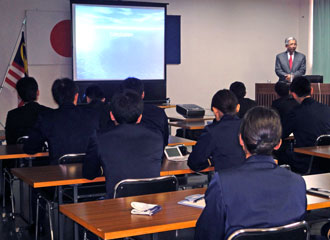 |
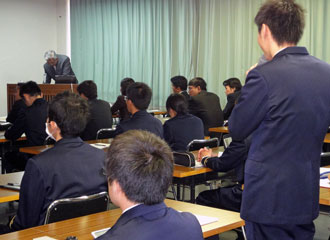 |
November 26, 2012 Participants visited Yoshiura junior high school
AJOC participants visited Yoshiura junior high school in Kure for exchange meeting with 90 students. The school visit was aimed to consider the regional cooperation and contribution to society where one’s organization is located through the interaction with local people. It was also aimed to provide an opportunity for the students to know about coast guard activities in Asia and the importance of English as a communication tool.
Participants introduced cultures and characteristics of their own countries to the students using slides and musical instrument in English in each classroom. During the Q&A session, students actively asked questions such as “What sport do you like?”, “What subject did you like when you were a student?” The participant from Indonesia answered that she had liked English because learning a foreign language helped her to understand other cultures.
Through the interaction with the school principal and students, participants could enhance their understanding about locality of Kure where the JCG Academy is located. They could also have a valuable opportunity to know about Japanese junior high school students who are going to forge the future of their country.
Participant performing a song of his country |
Commemorative photo in the principal’s office |
 |
 |
December 17 to 21, 2012 Ahoy KOJIMA!!
On 17th December 2012, AJOC participants started our on-board training in JCGA training ship KOJIMA. A number of activities were attended during 4 days training on the vessel. The training was specially attended by JCGA’s 4th year cadets as part of their 1-year ship-board training.
On the first day, after embarkation and settling into our cabins, we were given a familiarization tour of KOJIMA by the ship’s officers. In addition, we were also briefed about rules and regulations and daily routines and activities on the training ship. After that, we conducted a short rehearsal to prepare for the boarding ceremony the next day. After dinner, we cleaned up our cabins and prepared for inspection by the duty officer. We also gathered during night roll call with 4th year cadets, which ended their day after making full preparations for sailing on the next day. At 22:30, we went to bed, which was unusually early for us.
Ceremony on the deck |
Early morning exercise |
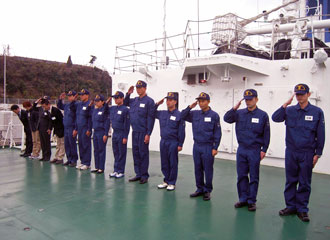 |
 |
On the second day, we woke up early, gathered on the deck of KOJIMA, and were accounted for together with the cadets. We also undertook morning physical exercise under the fresh, cold wind of Kure. We learned the special exercise moves for JCG personnel, like “push up the heaven” and “rowing the boat”. These special moves were made to conform to the limited space on a vessel. After that, we had the boarding ceremony, in which we had to introduce ourselves to KOJIMA’s officers, crew, and cadets. It was also a good chance for us to practice our Nihon-go!! Then our day started. We began our learning activities by observing the unberthing of KOJIMA from JCGA jetty. Next, we learned and observed the towing training between KOJIMA and KUROSE. After dinner, shower and ship inspection, we were separated into 3 groups to observe the duty activities on the bridge, engine room and communication room. It was a long day so we took our sleep earlier than the day before.
Observation of departure |
Observation of Navigation practice |
 |
 |
On the third day, we followed the same cadet’s routine on the training ship. On this day, in the morning we observed the approaching training on the bridge, where the cadets controlled and commanded the ship to approach a target under the trainer’s supervision. In the afternoon, we were given a lecture by a KOJIMA officer about the training system on-board ship, and had a good meeting and casual conversation with the boatswain of KOJIMA. We also observed the anchoring of KOJIMA as the last activity of the day. At night, we had a chance to spend time with the cadets, and shared experiences and knowledge between us. It was very nice to have delicious mid-night snacks together with the cadets in their mess.
Observation of towing training |
Special lecture |
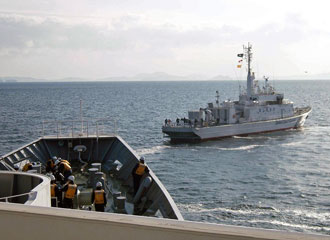 |
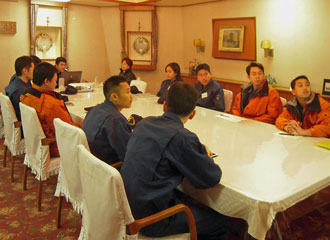 |
On the final day, we observed the anchoring of KOJIMA, the approaching drill in the bridge, and the berthing of KOJIMA at the Beppu Port. For us, we were given a great opportunity to observe, learn and review the training system on-board KOJIMA. For me, it is essential for MMEA as a new organization to have a strong basis for its training system for its officers. We were also able to make comparisons with the training system applied in our organizations. It is important to consider and develop our training system in accordance with JCGA, in matters such as classroom education and practical training on-board ship. Besides that, we deepened our technical knowledge about ship handling, and JCG’s procedures during ship operations and its daily tasks as a whole through observation and special lectures. Finally, we could also experience cadets’ life, discipline on-board ship, and safety measures necessary on a vessel.
Serving dishes by themselves |
Cleaning up with cadets |
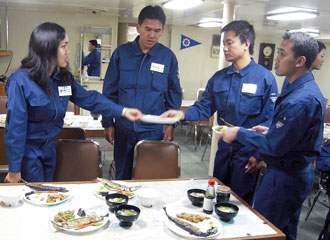 |
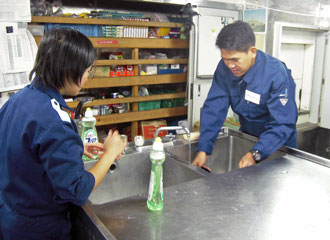 |
We said goodbye to KOJIMA after our disembarking ceremony. During the ceremony, a participant from Vietnam made a speech as a representative of AJOC. The speech was amazing, full of information, and emphasized the importance of the training to the cadets and to us. Most importantly, it was also the way to express our gratitude to KOJIMA’s officers, crew, and cadets. The memories, knowledge and experiences will be precious and will not be forgotten. Fair winds KOJIMA!!!
Entering into port |
commemorative photo |
 |
 |
February 4 to 7, 2013 STUDY TRIP TO HOKKAIDO
The last study trip program of AJOC class 2012 was finally completed with an extraordinary experience and fruitful trip on a winter days in Hokkaido Prefecture at 1st Regional Coast Guard Headquarters. On the first day, upon arrival at the airport in Shin-Chitose, AJOC participants were immediately fascinated by the beauty of snowy environment. After then, we went at the 1st Regional Coast Guard Headquarters to pay a courtesy call to the Commanding Officer. The commanding officer warmly welcomed the AJOC participants together with other senior officers of the headquarters. He was very glad to see us and he expressed his full support as he believed that our visit in their region would also be important and helpful to deepen more our understanding of the Japan Coast Guard mission, particularly the distinct duty and responsibility in their region. Among all of coast guard regional headquarters and offices of the Japan Coast Guard (JCG), only in the 1st Regional headquarters has an additional duty and responsibility, these include the ice breaking operations and data gathering of sea ice drifting for the information of maritime stakeholders. During our meeting, he also explained that their extra task is very relevant to coast guard duty of Southeast Asian countries. He pointed out of some vessels that might be going to pass through their region, may be the same vessels that will also pass through in the Southeast Asian region as it links within the so called great circle route for the vessels. So, the sea ice drifting information and breaking operations conducted by JCG are very important task to keep the integrity and seaworthiness of the passing vessels for the safety and security of the marine environment. On the other hand, he then announced the rare opportunity of accommodating us to join in their sea ice drifting observation operations onboard JCG aircraft Bombardier Q300.
Courtesy calll on Commander, 1st R.C.G.HQs. |
Lecture on coast gurad mission |
 |
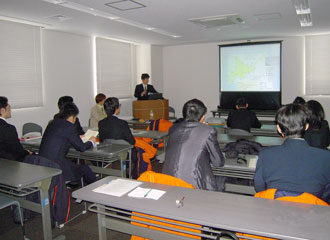 |
On the second day, AJOC participants boarded the JCG aircraft for the sea ice drifting observations en-route from Chitose airport western part then up to the vicinity of the Okhotsk sea northern part, down to Nakashibetsu Nemuro easternmost part of Hokkaido. The sea ice drifting observation took about more than three hours with an altitude of more or less 1,300 feet which made us completely exhausted after the flight because we were not used to stay long with the strong air turbulence of the aircraft for several hours but it was an unforgettable and learning experience for all of us and it was worth mentioning the spectacular scene of sea ice drifting formations.
Before boarding |
Observation of drift ice from the aircraft |
 |
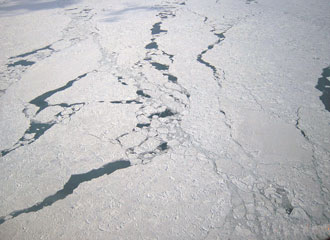 |
Our observation experience on the coast guard duty had not ended in the sky, yet on the third day, another exciting opportunity was granted to us by the Commanding Officer of Nemuro Coast Guard Office. Then again, we embarked the newest patrol vessel of JCG.
Courtesy call on Chief of the coast guard office |
Lecture on the main mission of the coast guard office |
 |
 |
Finally, it was indeed a great and wonderful learning experience being a coast guard officer for this very rare opportunity given to the AJOC participants. And it would not be possible without the full support accorded to us by the Officers and men at the 1st Regional Coast Guard Headquarters and the Japan Coast Guard Association staff. Thank you very much.
Observation of the patrol boat |
at Cape Nossapu, the easternmost of Hakkaido |
 |
 |
March 6, 2013 Presentation on the study results
All participants presented the results of their study in the class of their training on the final day.
They had conducted their research on the subjects that they selected respectively with the support of JCGA instructors and the training adviser.
Not only instructors but also the trainees of other course attended the class. There was a lively exchange of questions and answers.
Participant presenting his study result |
Participant presenting his study result |
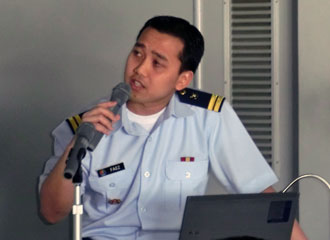 |
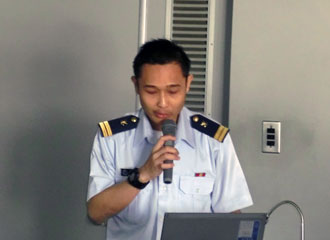 |
Exchange of questions and answers |
Exchange of questions and answers |
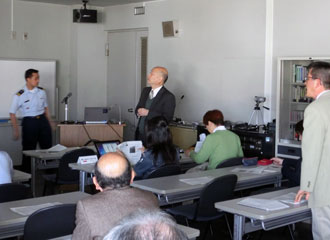 |
 |
Participant presenting his study result |
Participant presenting his study result |
 |
 |
Participant presenting his study result |
Participant presenting his study result |
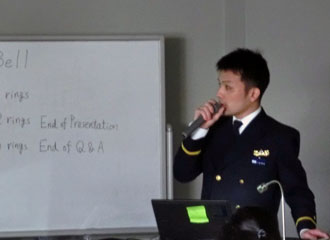 |
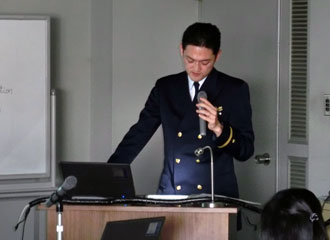 |
Participant presenting her study result |
Participant presenting his study result |
 |
 |
Participant presenting his study result |
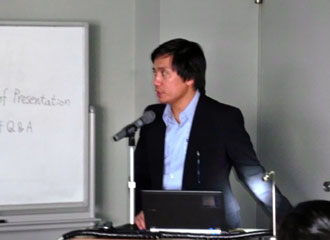 |
March 6, 2013 Completion of the 2nd Asia Coast Guard Junior Officer Course of Japan
At the completion of the 2nd Asia Coast Guard Junior Officer Course of Japan (AJOC), the closing ceremony was held at the Japan Coast Guard Academy.
Superintendent of the Academy presented the certificate and gifts to all participants.
The participant of the Philippines was also commended by the Superintendent for his outstanding achievement.
presentation of the certificate and gift |
presentation of the certificate and gift |
 |
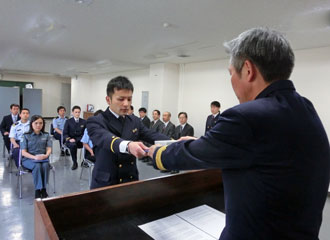 |
presentation of the certificate and gift |
presentation of the certificate and gift |
 |
 |
presentation of the certificate and gift |
presentation of the certificate and gift |
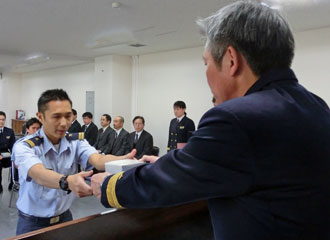 |
 |
presentation of the certificate and gift |
presentation of the certificate and gift |
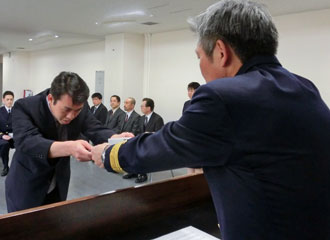 |
 |
all participants |
commendation |
 |
 |
address by the Superintendent |
commemorative photo |
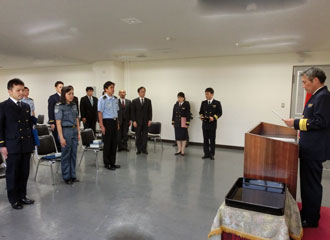 |
 |
After the closing ceremony, a farewell party was held. Vice Superintendent delivered a speech and each participant also made a speech about the result and memories of their long-term training.
During the party the local song of “Ondo no funauta”, a Ondo boat song, was performed. The pariticipants had a good time with those who had become to know in Kure and they were reluctant to part from them.
speech by Vice Superintendent |
speech by the participant |
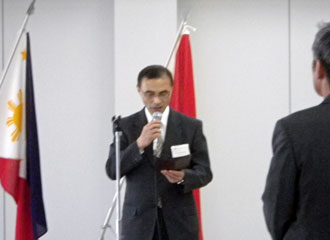 |
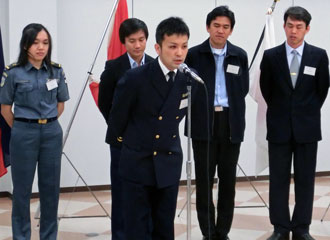 |
performance of Ondo boat song |
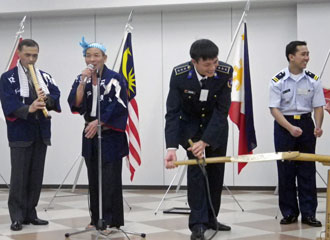 |
commemorative photo |
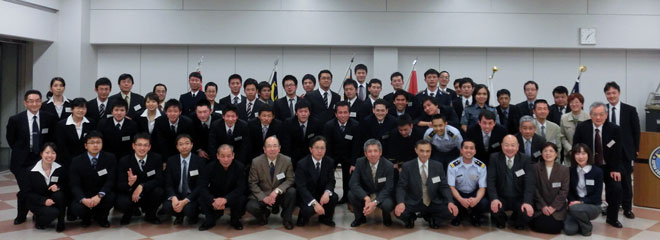 |
this one can be enlarged by clicking on this |
March 8, 2013 Participants visited Japan Coast Guard
Nine participants made a courtesy visit to Japan Coast Guard after completion of their training.
Each of them reported the result of the training and expressed their deep appreciation to Commandant of JCG.
Commandant made a congratulatory speech on their completion of the long-term training. He also expressed his hope that the participants will make use of not only the knowledge they got through the training but also a good relationship between them to have great success in the future.
Participants reporting their result |
Present from the participants |
 |
 |
Commemorative photo with Commandant and executive officials |
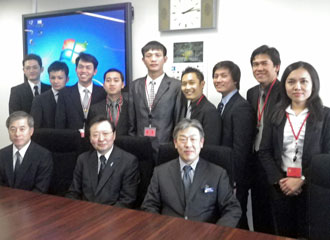 |
March 8, 2013 Participants visited the Nippon Foundation
Nine participants of the Asia Coast Guard Junior Officer Course of Japan made a courtesy visit to the Nippon Foundation after the completion of their training.
Each of them expressed their gratitude to Mr. Ogiue, leader of Maritime Safety & Education Team, Maritime Affairs Dept. for the support of the Foundation. They also told of their experience, achievements and the strong bonds between the participants in Japan for the last 11 months as the result of the training.
Mr. Ogiue mentioned that all the participants appeared confident and pleased having fulfilled the training. He also encouraged them to contribute to safety of the oceans with their hard-won knowledge and experience.
Participants reporting their result |
Presenting a gift from all the participants |
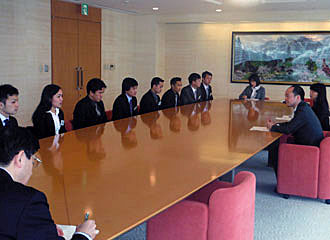 |
 |
Group photo in the room at the Foundation |
 |
March 9, 2013 Participants left for their countries
They left Narita Airport for their countries.
We wish their smooth sailing!
Bon voyage!
for Philippines |
for Malaysia |
 |
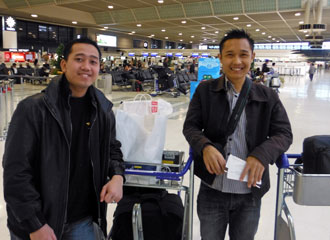 |
for Vietnam and Indonesia |
 |
Participants Life in 2012/2013
| Date | Activity |
|---|---|
| April 16 | |
| April 23 | |
| May 2 | |
| May 27 | |
| May 31 | |
| July 13 | |
| August 18 | |
| August 17 | |
| August 24 | |
| October 6 | |
| October 12 | |
| December 14 | |
| January 7 | |
| March 1 | |
| March 7 |
April 16, 2012 Overseas participants arrived at HIP
Overseas participants arrived at Hiroshima International Plaza. They were given the brief explanation about the facility by the program officer of Hiroshima International Center.
Cherry blossoms in full bloom at HIP |
Participants arrived at HIP |
Brief explanation about the facility |
 |
 |
 |
April 23, 2012 The Japanese language class started
A six-day intensive Japanese class started. Participants are learning useful phrases for their stay in Japan such as greetings and self-introduction. Practice activity outside the classroom is planned. All of them are very active in the class.
Participants learning greetings |
Participant introducing himself in Japanese |
When receiving a present, what to say? |
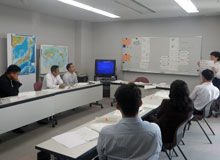 |
 |
 |
May 2, 2012 Participants tried Ikebana
Participants learned Ikebana, flower arrangement, as part of Japanese culture experience at the Hiroshima International Plaza.
Starting with the Japanese style bow, they had an Ikebana lesson. During the lesson they introduced themselves and expressed their impressions in Japanese that they had just learned. It was a good opportunity to review their Japanese.
The beginning of the lesson |
Happy to be praised by instructors |
Participants arranging it one by one |
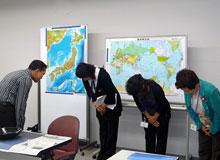 |
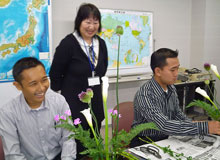 |
 |
More beautiful by the advice from instructors |
||
 |
 |
 |
May 2, 2012 Participants learned what Ikebana is
Ikebana is the art of arranging flowers. It derives from a Japanese word "ike" means to arrange and "bana,” originally from the word "hana" meaning flower. That was one of our practical lessons, flower arrangement, to learn more about Japanese culture. It was explained to us that in Ikebana, the flowers and branches are arranged so that they appear in a beautiful, simple, and natural way. The problem is that I never like flowers back home so I thought this one would be tough.
I was not into flowers because in the Philippines, it is more associated with women and symbolizes femininity.
Then suddenly, I found myself arranging flowers, and yes, I enjoyed it. Indeed it helped me understand more about Japanese culture but most importantly, as I look closely on each flowers, I realized that life itself is comparable to a flower. Before when I saw flowers, I just looked at it as pretty and they smell good, but what’s the point? They are all just going to die anyway.
But Ikebana lesson taught me the purpose of flowers. Eventually, it came into my mind that flowers were created not just to enjoy their fleeting beauty, but to also remind us of the fragility of life and that life is as beautiful and colorful just like flowers. It takes a moment for us to truly appreciate the beauty of a flower, just as we should always remember to enjoy and appreciate the ones we love. Being away from home, I have learned that life is short to take the time we have together for granted.
Flower is also the most effective tool to express our feelings. It has the power to convey profound human emotions and thoughts the way no other object can. Whenever our feeling are too intense for words, be it love, happiness, grief or gratitude, flowers will express our feelings perfectly.
Now, I fully understand the meaning of flowers in our lives and the message that it brings. As I learned how to appreciate flowers more, the more I see how beautiful life can be.
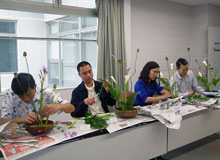 |
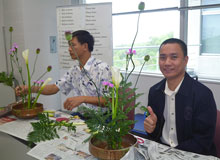 |
 |
May 24, 2012 Nihon-Go Class: the beginning of life in Japan
People said that to be able to speak another language is beneficial. True. To be able to talk and understand words in Japan is essential, especially when one already in the country, like me!
For that the Intensive Class of Japanese Language (Nihon-Go) was arranged at the Hiroshima International Plaza. The class started last April 23rd 2012 for 6 days, and will continue once a week on every Friday night until the completion of AJOC.
At first we were worried because this is a new language we learn and whether we can absorb it or not. However, Nihon-go is not so hard to learn. The teaching materials, the methods and applications given by the sensei made it easier for us to learn. Sometimes we sing the Japanese words and sometimes we watch videos about the conversation, and apply it to each other.
During the intensive classes, we’ve learnt the basic of Nihon-go, such as the introduction to the language, self-expression, greetings, basic conversations at restaurant, during shopping and travelling. We also learnt how to deliver opinions and how to visit somebody in Japan.
The class was very lively when we were given the chance to speak to each other in Japanese, and more exciting when we talked to real Japanese people; the sensei, the student-teacher from University of Hiroshima and staff of HIP. It gave us confidence to apply Nihon-go during shopping and travelling. Nervous at first, but satisfied when we completed the conversation. Of course we can’t speak Nihon-go fluently yet, but the basic conversations help us in many ways.
For us, the class is beneficial and we felt so grateful to learn Japanese language and converse with a lot of nice Japanese people in more friendly and confident manner.
Thank you for giving us this class. Arigato Gozaimasu!
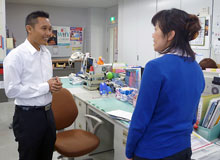 |
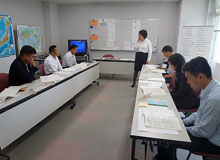 |
May 27, 2012 GANBATTE!! : ATHLETIC FESTIVAL
All AJOC participants joined the athletic festival, which took place at the Higashihiroshima Misonou Elementary School.
During the event, the participants were given a chance to participate in several Japanese traditional games such as bun-snatching race, relay races and other games. We also showed the “POCHO-POCHO-DANCE”, Indonesian traditional dance, to the pupils and their parents.
After dancing, each AJOC participant headed by Canny went to the group of pupils to individually teach them the “POCHO-POCHO-DANCE” steps and later on had the chance to dance with them all together.
Volunteer students of Hiroshima University and foreign students from various countries also joined the athletic festival, and I’m sure that it was an enjoyable day to the foreign participants, as well as Japanese participants. The said activity was an opportunity for the Japanese participants to promote friendships with foreign delegates.
I hope this kind of event will continue in the future because this is not just all about competition, winning or losing, but the camaraderie among Japanese and foreigners that was established. I believe that is most important.
Participants walking to the school |
Attending the opening ceremony |
Participant running out in the relay |
 |
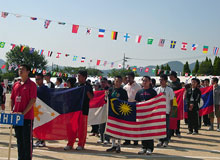 |
 |
Participants instructing the dance |
All stepped to the music |
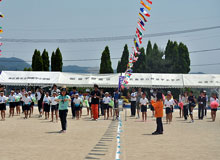 |
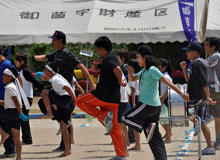 |
this picture can be enlarged by clicking on this |
May 31, 2012 Yukata-wearing class
Before coming to Japan, I used to watch Japanese historical movies and I always thought that all traditional clothes in Japan were Kimono, only a unique type. But after arriving in Japan, exploring the long-term culture and its richness, I realized that I was wrong. Kimono is the best known article of Japan's traditional dress. Japanese people usually only wear Kimono on special occasions. However, in summer Japanese often wear a simpler type of Kimono known as "Yukata." Yukata is the most casual type of Kimono for summer use. It is easier to wear than any other varieties. This is a casual Japanese summer dress worn by both genders.
I had wanted to be dressed up once in Yukata to feel a part of the identity of Japanese culture that I want to explore. The opportunity came when we had a Japanese lesson on the subject of Japanese culture. All participants from ASEAN countries were eagerly watching the Yukata wearing. After listening to instructions on how to wear, we began to put on Yukata. Japanese instructors helped us get dressed. The Yukata was so beautiful! And I never thought that they're so tight around the waist. We even wore the traditional slippers and we all became brilliant. All participants tried to communicate with our teachers and instructors in Japanese. Then we took lots of pictures. All participants felt so proud and happy to enjoy and experience such Yukata wearing!
Do you want to try once? It is easy to wear and of high comfort. I am convinced that you will love your Yukata. Let's enjoy original Yukata and Japanese culture!
Explanation of Yukata |
Participants putting on Yukata |
Ribbon making helped by the instructor |
 |
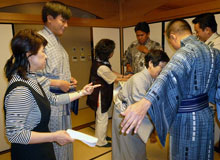 |
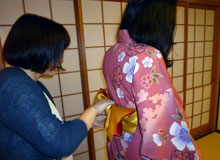 |
Participants putting on Yukata |
Comfortable and nice |
Group photo of Yukata-wearing class |
 |
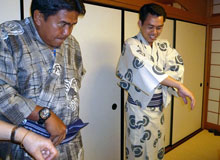 |
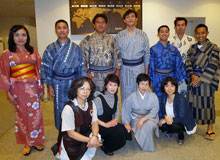 |
| This picture can be enlarged by clicking on this |
July 13, 2012 Origami Lesson
…and how it brings back childhood memories to AJOC participants
Who could forget the paper boat that we used to play during rainy days or the paper plane that we used to throw on air till it lands? Those were some of the games that we used to play when we were still kids and now, as Origami was introduced to us, we were so amazed that paper folding is not just a game for kids to play but it’s actually a part of Japanese culture.
As we continue our journey to learn and discover more about Japanese cultures, we surely cannot miss Origami, and all of us, AJOC participants, were so indulged and extremely focused as our sensei taught us step by step the proper way to make a piece of square paper into a creature that we never thought to be possible.
Origami may be simply defined as a traditional Japanese art of paper folding that aims to make interesting objects from only one piece of paper without cutting it or using glue. But it is not as ordinary as it seems to be or some people may see it as something that is for children. It speaks about Japanese culture and a tradition that started long time ago and must be introduced or passed on to the next generation for them to appreciate a simple art work.
In this time wherein artists use digital media to improvise and develop their ideas, it is interesting to note that Japan, one of the most advance countries in the world when it comes to technology, still manage to preserve this kind of traditional artwork and we are so fortunate that they shared this to us. In the midst of all these computer generated toys and artwork, origami is something that keeps us getting back to paper when we want to brainstorm ideas in the same way how we use our notebook, doodle around in a sketchbook, collect inspiration in a scrapbook or just draw some sketches to express our artistic side.
To the people behind this Origami lesson/lecture, thank you very much. Let our journey to discover more about Japanese cultures and tradition continue.
I hope I’m doing it right… |
Group message to their finished product |
 |
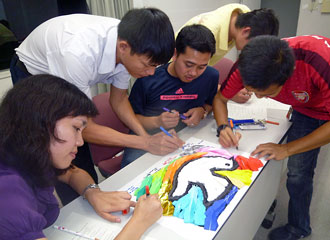 |
Proud smile from AJOC participants, “ yes we did!” |
Simple message from AJOC participants: |
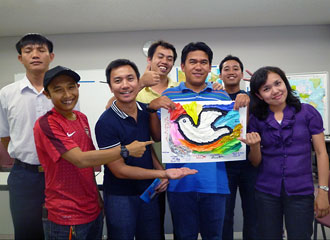 |
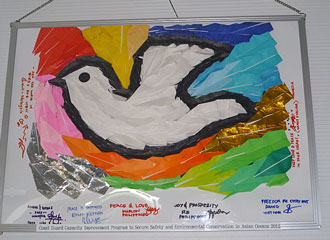 |
August 18, 2012 SAIJO BON ODORI TAIKAI
AJOC participants joined the Saijo Bon Odori Taikai or Bon Dance Festival which was held near Saijo bus station. This festival is celebrated by Japanese people every year on the 15th day of the seventh month of the lunar calendar. It has been celebrated in Japan for more than 500 years and traditionally includes a dance.
Firstly, all the participants saw some Japanese people on stage competing in the loud shouting contest. They could shout any Japanese words loudly in front of the sound meter and the winner received a prize of watermelons. I thought it is good for hot summer time.
Secondly, we enjoyed the Bon Dance together with Japanese people (our guiders) from the surrounding community. Every participant seemed very excited to learn the art of the Bon Dance. There are 3 steps of the Bon Dance. It becomes more and more quickly with traditional rhythm instrument. Although the Bon Dance was very difficult for us, we liked it so much. This festival was a very good opportunity for us to get to learn about Japanese culture.
Finally, colorful fireworks had been shown in the end of the Bon Dance Festival. All participants could feel the sound and the light so beautiful. Thank you for all!
Ready to try a bon dance |
Enjoyed seasonal event with local people |
 |
 |
Learning the dance by doing |
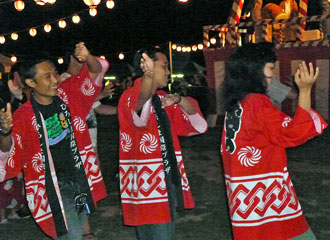 |
August 17, 2012 Watashi no machi Hiroshima
Have you ever stood in front of everybody to introduce good foods, souvenirs or spectacular natural scenery of your country that you are always proud of? And we have experienced such happy moment. That was a moment when we were standing in front of our teacher and close friends who had come from ASEAN countries, in the Japanese classroom to start by saying “ Kombanwa, Watashi wa…Watashi no machi…”
We all had 30 minutes to prepare our presentations. All participants tried to search more pictures on foods, souvenirs, sites and so on as fast as possible on the Internet. When everything was ready, we started to introduce our presentations (of course in Japanese!). One by one, each participant became an ambassador of his/her country in efforts to introduce cuisine culture, delicious foods, lovely souvenirs as well as hidden charm of wonderful places.
“Well, Philippines is indeed great with natural wonders and rich in diversity in ethnics groups and foods. Indonesia, the country has more than 17,000 islands with good beaches like Lombok, Bali, Yogyakarta, and much more... Malaysia, it is famous for Batik, a beautiful souvenir costume with a hand-drawn or printed motif, available in traditional and contemporary styles. There are varieties of Batik items to choose, from Sarongs, shirts to dresses. Not only that, cushion covers, place mats and tablecloths are also available. Those will instantly give a touch of class to your home. Now, we come to Vietnam, the country is famous with Pho, a food with noodle and beef, and of course with a lot of herbs such basil, coriander, mint and a number of related herbs found everywhere in Vietnamese markets. You can also visit many wonderful places in Vietnam from old citadel of Hue City to sunny beach Nha Trang in Central Vietnam or experience wartime life in underground tunnels in Cu Chi, north of Ho Chi Minh City, as a refuge for Vietnamese soldiers during the Vietnam War”.
We ended our presentation in the pride of cultures of ASEAN countries. Thanks to our dedicated teachers, AJOC and Japanese class we have the opportunity to learn the language of the country of the rising sun and had a chance to introduce our countries. We also do not forget that we are living the happiest days in Japan, the land of cherry blossoms and Mount Fuji with the delicious foods soaked by Japanese soul. At that moment, suddenly we wanted to say: Watashi no machi Hiroshima, Nihon. Thank you, Japan, MY LOVE!
“My town" information is posted |
Some Vietnamese food introduced |
 |
 |
this picture can be enlarged by clicking on this |
this picture can be enlarged by clicking on this |
Philippines is displayed |
Various information on Malaysia |
 |
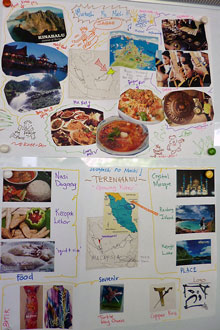 |
these pictures can be enlarged by clicking on |
|
All about Indonesia |
 |
this picture can be enlarged by clicking on |
August 24, 2012 Katazome; revealed our creative side
Another culture class for AJOC Program has been carried out. Unlike the other Japanese culture classes, this session revealed our creative side of painting, showed our art of coloring, and added more elements to make it attractive and beautiful. It is called Katazome. The session began with our self-introduction to the Sensei, and the sensei took about half an hour to explain about this art. Katazome is a Japanese method of dyeing fabrics using a resist paste applied through brush. We used 3 kinds of brushes with different sizes. The unique thing about Katazome is that the colors are made by rice flour. Color is added by hand-painting (brush), and dried later. After the paste mixture covers and permeates the cloth, the dye will be dried to make it permanent. The fabrics will be washed, and will be dried to preserve the art. To summarize, the art of Katazome focuses on coloring the unique patterns or pictures on the fabrics, and it’s up to the painter to choose the colors in order to make the fabrics colorful and attractive. Katazome has the same application with Malaysian’s and Indonesian’s Batik, with slight differences on the painting method.
Participants learning how to do it |
Participants choosing various colors |
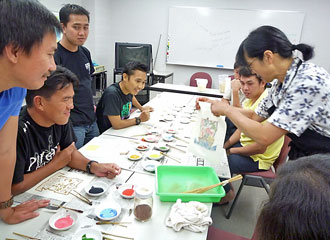 |
 |
In this session, we used the picture of a wooden sailing ship voyaging on the sea. In the picture, the ship brings those; 1 treasure chest, coral reef, a fish, a key, flower and it’s leaves, hammer, a bag full of money, and 2 fans. Weird!! Actually this unique picture with unique elements bears meanings and every item represents a symbol, mainly on prosperity and happiness. They also represent the unique culture of Japan by the Sakura flower, fan and the unique katakana. The next step is to put color on the picture, and we were free to choose the colors, depending on our creativity. I chose to paint the fish in gold color, the fin and tail with red color. The final step was to add more painting on the blank spot around the picture. I chose to put a Malaysian flag on the ship, and a volcanic mountain as background (as I remember the amazing scenery of volcanic mountain Sakurajima during our study trip at Kagoshima before). After the finishing touch, the sensei took the fabrics to be washed and dried, made us impatient because we were so eager to see the result right away. 1 week after, we received the colorful fabric, smiling with satisfaction when we look at it and stored well in our room, as it was the proof of our creative side on art. Moreover, we also added our knowledge and applied another Japanese art and culture. We hope happiness and prosperity in our life, just like what the picture represents.
Masterpieces of artists |
Masterpiece of an artist |
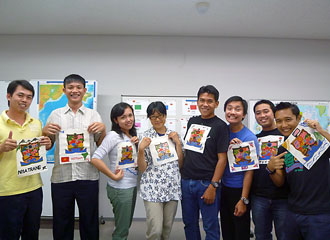 |
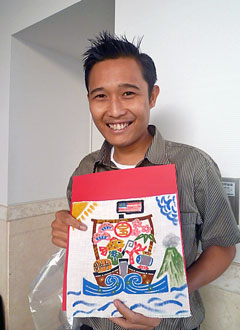 |
these pictures can be enlarged by clicking on |
|
October 6-7, 2012 Saijo Sake Festival
SAKE- THE MASTERFUL BREWS OF JAPAN
In October for just one weekend, the town of Saijo in Higashi-hiroshima comes alive for its famous sake festival. Sake breweries open their doors to the public as part of annual sake breweries open day. Saijo is a well-known brewery town since 17th century and has several traditional brewery facilities. Within the narrow streets of the Sakagura Dori area near JR Saijo station, the Namako wall (white-lattice walled) and Sekishu Gawara (red-roof tile) roofs are well-known as sake breweries.
In this festival, finest sake from all over Japan is gathered here and the opportunity is given to taste the different variety at one place. The event is visited by thousands of local and foreign tourists. They enjoy taking a walkthrough the historic sake breweries street and are attracted by various stalls that sell local foods and snacks along the road. The road leading to the Chuo park is split into two: one side of the street has stalls, variety of street foods, stages and other performances with free entrance. On the opposite side of the park requires entrance fee where you will be handed your own sake cup upon entry then you can be refilled at any of the Sake stands where you can get to taste hundreds different types of sake flavor from all over the region and you can drink merrily as you can or for up to nine hours if you want.
The festival was also highlighted with a dynamic Midarebayashi drum parade composed of children, school institutions and participants from HIP joined in this momentous occasion.
The lighthearted atmosphere of the festival was almost as good as sake itself and made a great day out. It was great seeing so many people who love sake, the masterful brews of Japan & Japanese culture. In order to remember the visit to the sake festival, don’t forget to purchase wooden sake cups as souvenirs.
Thanks Hiroshima and its great people.
Ready for the drum parade |
Entering to the famous sake brewery facility |
 |
 |
Walking through the historic street |
Kampai! Very happy with free sake |
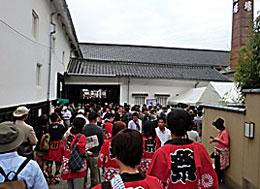 |
 |
October 12, 2012 Sado, the Japanese Tea Ceremony
Today, AJOC participants had a chance again to explore and experience one of the special events in Japanese culture that has been practiced since a long time ago until today and has not lost from time immemorial. The Japanese tea ceremony or Sado in Japanese is the traditional ceremony in Japan which is a ritual that prepares and serves Japanese green tea, called Matcha, together with traditional Japanese sweets.
First of all, the Sensei taught us how to sit in Seiza position and bow on the Tatami mat as male and female. But for those who are not familiar with that position felt quite difficult to sit longer with that way. Then, she started to explain a brief history of the tea ceremony in Japan that is usually done during the exchange between seasons.
After that, the Sensei taught us how to fold the paper to be used as pedestal of Japanese sweets. Then we were served with Japanese traditional sweets called Wagashi made from beans. The reason we eat the Japanese sweets with Japanese tea is to balance with the bitter taste of the tea. But it is not to be eaten immediately, we must bow in front of the dish of sweets and say “osakini” (show the excuse for the lead) and it must be followed by the predefined movements and then with both hands we move the dish to the right to the next guest. The commencement of the ceremony was very polite and orderly. The sweets also looked very attractive and appetizing. It was made from beans and eggs.
Finally, the Sensei showed us the ritual preparation of tea step by step. The equipment used during the preparation of tea was Natsume (tea caddy), Chakin (white cloth to clean the tea bowl), Chasen (tea whisk), Chashaku (tea scoop), Chawan (tea bowl), Fukusa (silk cloth to clean the Chashaku and the Natsume, usually the red color for women and dark color for men), Furo (portable brazier), Hishaku (long bamboo ladle), Kama (iron pot), Kensui (for waste water receptacle) and Matcha (green tea powder). We were all impressed and excited to see the preparation of the tea by the Sensei because each step of the preparation had its own art and style or movement. The movement appeared to be very polite, showed the spiritual depth, respectful of the guests coming and treated with the utmost humility. That’s the secret of harmony in this ritual.
Then it's time for us to feel the taste of Japanese tea. Before drinking, first we raised the bowl with both hands and rotated clockwise the bowl on the left hand twice and then drank it. After finishing, we needed to wipe the rim of the bowl with our fingers and rotated the bowl back into counterclockwise. During the tea ceremony, the guests can talk to each other, but in a low tone.
I think this class has achieved its goal to introduce Japanese culture deeper to the AJOC participants. They all seemed very excited and happy with this activity and we are looking forward to discovering and experiencing more Japanese culture for the next time.
Guidance from the Sensei |
Procedure for making tea |
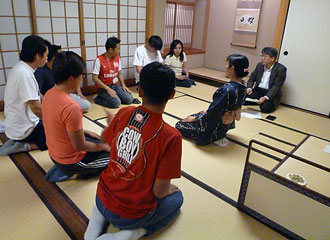 |
 |
Beautiful sweets were served |
Tasting Matcha, green tea powdered |
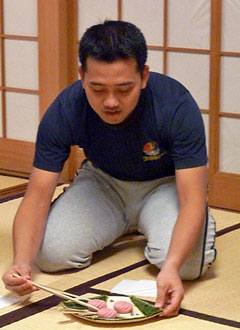 |
 |
Explanation of tea-making utensils |
Commemorative photo after the lesson |
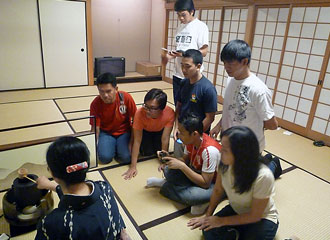 |
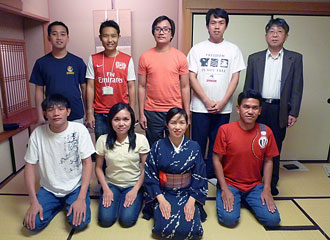 |
December 14, 2012 SEND YOUR MESSAGE WITH ETEGAMI
Nowadays, there are many gadgets for sending your messages, such as cell phones and e-mail, etc. But what do you think about sending a message by postcard? Maybe you think that it’s not up-to-date or it is only a card in which you write a message by hand and then send to your friend, family or others? If you think so, you should try to make etegami. It’s fun and you can know whether you are good in art and philosophy or not.
In Japanese culture class, the sensei explained about etegami. She said that etegami is a Japanese illustrated postcard in which you can draw a picture and write 2 words that describe what you feel about the picture. The combination of the picture and words describes your intention to the person who will receive your postcard or in other words, conveys it by postcard instead of by present, poem or gifts.
The sensei equipped us with 2 different kinds of brushes and white color postcards. The first brush had a pointed tip and thin stick to write a message and draw a picture. The second brush had a thick tip and quite a big stick to color the picture. One of the unique things about making etegami is the way you hold the first brush because you have to hold the brush perpendicular to the postcard before you can start to draw a picture. The other unique thing in making etegami is coloring the picture. Holding the brush in the same way, you start coloring the picture and you have to slightly merge the tip of the second brush into the picture. After drawing and coloring, the next step was to write a message.
The sensei provided some words in Japanese character such as:
| Sea ⇒ 海 | Love ⇒ 愛 |
| Winter ⇒ 冬 | Defense ⇒ 防 |
| Life ⇒ 命 | Spring ⇒ 春 |
Then the AJOC overseas participants had to choose 2 words that connected with each other (like philosophy words) and wrote them by using the first brush. We held the brush perpendicular and wrote the words on the top of the empty space around the picture. Writing a message in Japanese characters was difficult for us because we use alphabet in writing letters. It was our first time to write Japanese characters by using a brush, but finally we made it.
Participants learning how to do it |
Participants choosing various colors |
 |
 |
At the end of the class, the sensei gave 1 of her masterpiece illustrated postcards to each of us. What an interesting Japanese culture class it was!!! We are looking forward to experiencing another Japanese culture.
Masterpieces of artists |
 |
this picture can be enlarged by clicking |
January 7, 2013 MAKIZUSHI TO OKONOMIYAKI WA OISHIKATTA DESU
Aside from learning Japanese language and culture, AJOC overseas participants also had a chance to make the Japanese dishes Okonomiyaki (Osaka Style) and Makizushi. We were taught by 3 volunteer teachers who live nearby Hiroshima International Plaza, HIP.
Maki means roll and zushi means sushi, so Makizushi means a rolled-sushi. The other dish was Okonomiyaki, which is sometimes called as “Japanese pizza.” Okonomi means favorite and yaki means fry, so Okonomiyaki means fry it as you like it. There are 2 styles of Okonomiyaki, which are Osaka style (everything is mixed in the batter) and Hiroshima style (the ingredients are layered not mixed.) Although Saijo, where the AJOC participants live is next to Hiroshima, in the class we cooked Okonomiyaki in Osaka style.
Before starting cooking, AJOC overseas participants had to wear colorful aprons with cartoon caricatures that made us look like professional chefs from “Master Chef” (the TV cooking competition.) After wearing the apron “adventure” of cooking the Japanese cuisine begun. The first dish that we made was Makizushi. It is one of the favorite Japanese foods of some AJOC overseas participants. The sensei explained that the rice to make Makizushi was made from ordinary rice and mixed with Japanese vinegar, which tasted sweet and sour. Then they demonstrated how to make Makizushi and AJOC overseas participants followed them. At first, we put one piece of nori (dried seaweed) on a cutting board and poured the rice on the top of the nori. Then we put 2 or more pieces of boiled processed-crab meat, tuna fish, cucumber, omelet and vegetables on the top of the rice. The last step was to roll it using a rolling tool made of bamboo. After that, we cut the Makizushi into some pieces and put them on a plate and as a final touch we garnished the Makizushi with strawberries. The next dish was one of my favorite Japanese foods, “Okonomiyaki.” It contained seafood ingredients such as boiled shrimp, boiled processed-fish meat, squid and leeks, mixed with Okonomiyaki flour. We poured one spoon of cooking oil into a pan and fried the Okonomiyaki dough.
Within an hour and a half the Makizushi and Japanese pizza “Okonomiyaki” were ready. As a topping for the Okonomiyaki, we sprinkled aonori (green nori seaweed) and katsuobushi (sliced dried bonito) and then poured mayonnaise and Japanese soy sauce over the Okonomiyaki, as we liked. Then the AJOC overseas participants, the sensei and one staff of HIC started to eat, saying “itadakimasu” which means “we are grateful for the food.” After eating, we made one clap and said “gochisosama deshita” which means “thank you for the delicious food.”
One thing that I learned in this class is that Japanese cuisine uses less seasoning, oil and lighter cooking processes so that the nutrition and flavor of all the ingredients still remain without mixing with the seasoning or disappearing through many cooking processes. It can be said that Japanese food is a healthy food.
We are ready to make Japanese dishes |
Making the Makizushi is fun |
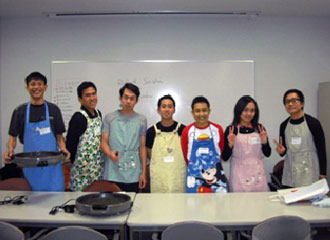 |
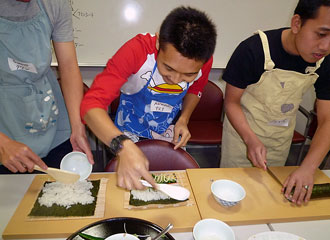 |
The Makizushi is well prepared |
The Okonomiyaki is under process |
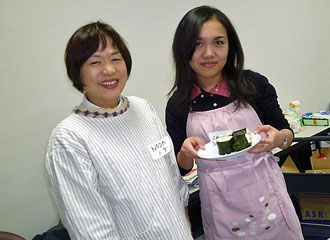 |
 |
Turning over Okonomiyaki needs a special skill |
Group photo with our sensei |
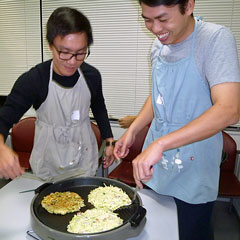 |
 |
March 1, 2013 Completion of the Japanese language class
Overseas participants completed the Japanese class with excellent results.
They have attended the evening Japanese class at Hiroshima International Plaza, their residence, since they arrived in Japan.
They were given certificates of completion and gifts at the closing ceremony from the instructors who helped them a lot.
Japanese participants also attended the ceremony to congratulate them on their completion.
On this occasion, each of them made a short speech in Japanese to express their impressions about their stay.
Closing ceremony |
presentation of a certificate |
 |
 |
presentation of a certificate |
presentation of a certificate |
 |
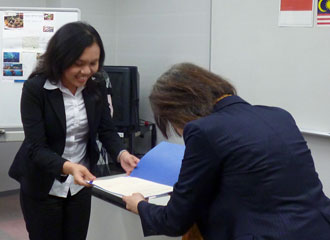 |
presentation of a certificate |
Short speech |
 |
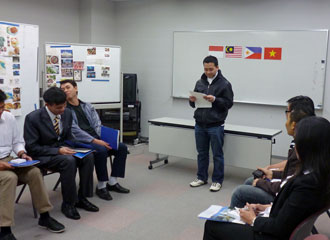 |
Short speech |
Short speech |
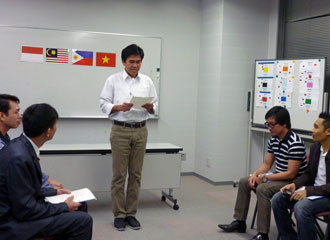 |
 |
Short speech |
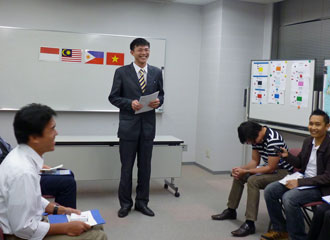 |
Commemorative photo with instructors |
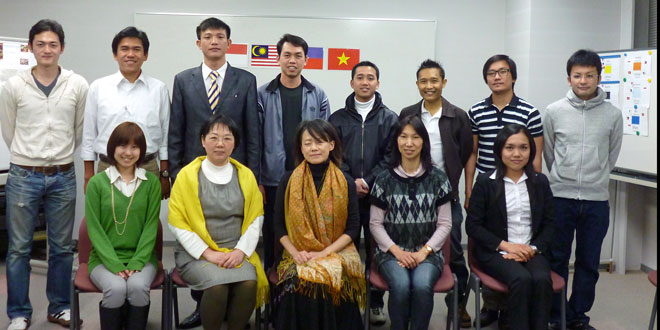 |
March 7, 2013 Participants left the Hiroshima International Plaza
After saying to the staff of the Hiroshima International Plaza, “Thank you very much, see you again”, Participants left there with tears in their eyes.
Their stay stretched over 11 months since April, 2012. They had never come back to their countries and received the intensive training at that time.
Smile expressing his appreciation |
 |
Group photo with staff |
 |














